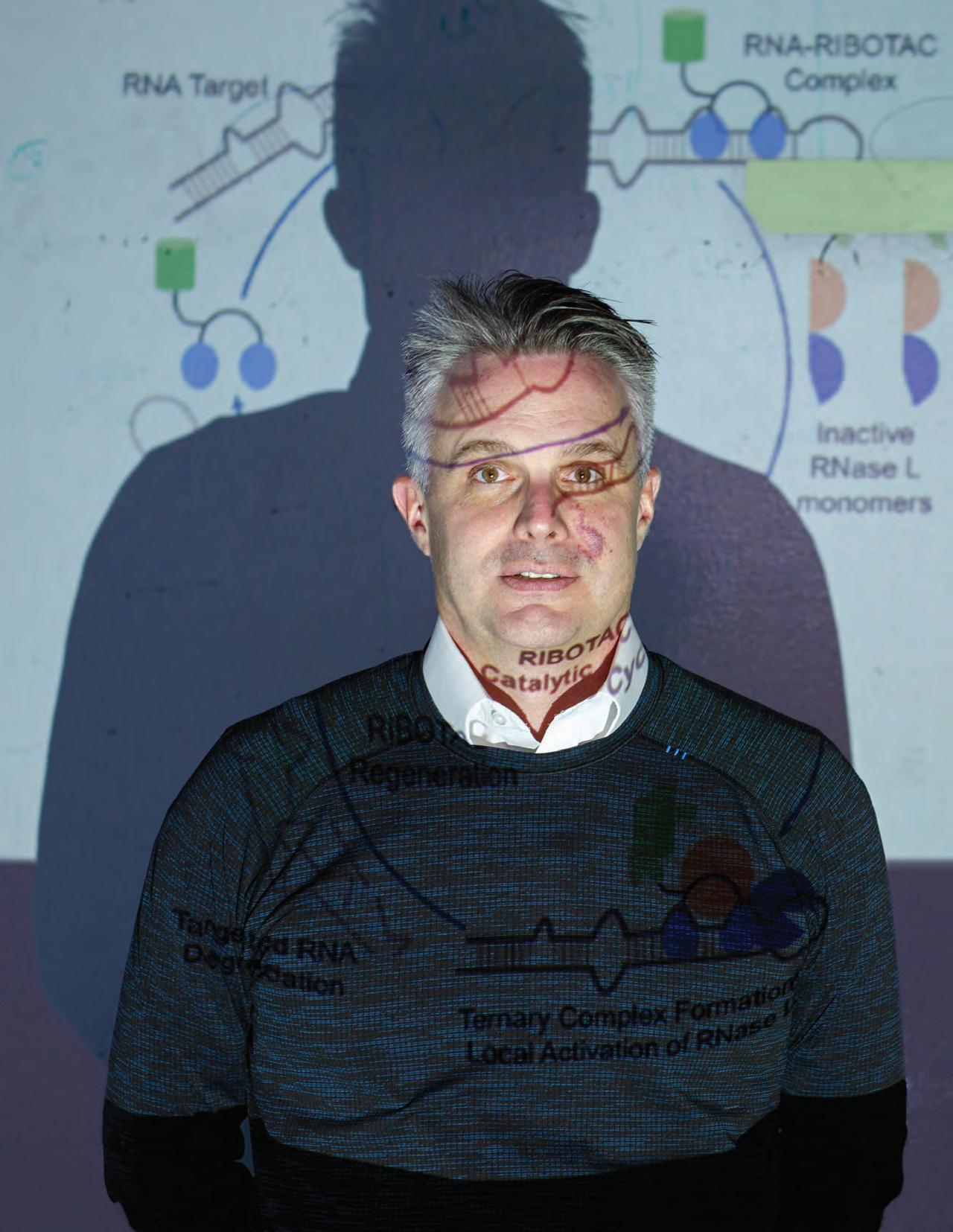
Libraries of Hope
RNA-focused drugs take center stage
SPRING 2024 Unpacking Hoarding An Ancient Threat Presidential Priorities Cosmic Sound
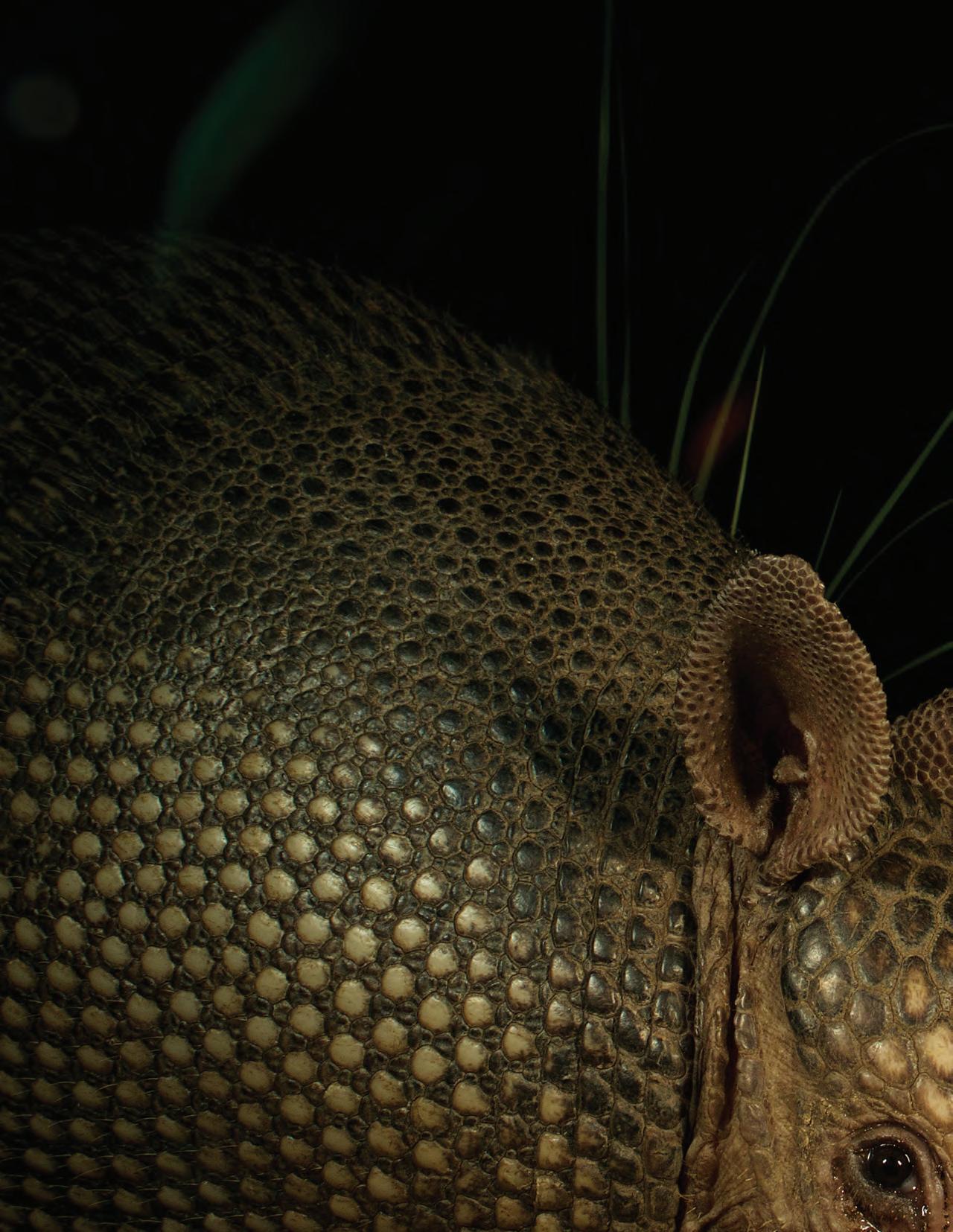 About the cover: Chemist Matthew Disney in his lab at the Herbert Wertheim UF Scripps Institute for Biomedical Innovation & Technology in Jupiter, Florida.
About the cover: Chemist Matthew Disney in his lab at the Herbert Wertheim UF Scripps Institute for Biomedical Innovation & Technology in Jupiter, Florida.
Spring
Lawrence Reeves
Cover photo by: Scott Wiseman
2024, Vol. 29, No.1
Extracts
News from around the university
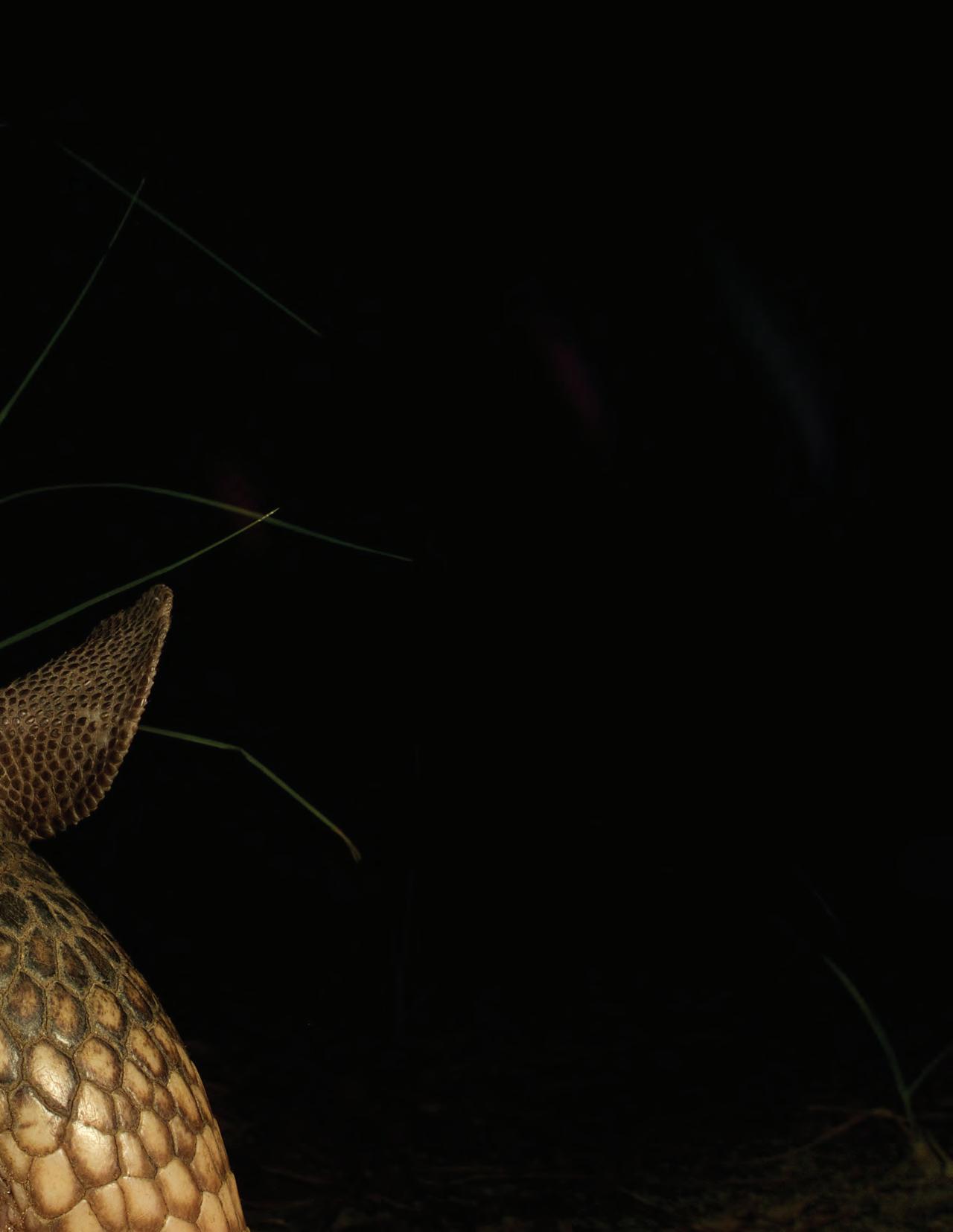
12 Targeting RNA
Chemist Matthew Disney is leading a revolution in drug discovery
18 42 6 26 32 40
Leprosy is Here
A UF team puts science over stigma to stop the spread of Hansen’s disease in Florida and beyond
Unpacking Hoarding
New hope for a disorder that’s about more than too much stuff
Roadmap to Florida’s Future
New initiative jumpstarts projects that “will change lives for years to come”
Musical Marvel
Hollywood has taken notice of this engineerturned-composer’s AI-infused art
Shark Stories
“Jaws” portrayed sharks as monsters 50 years ago, but it also inspired a generation of shark scientists


Explore is published by UF Research. Opinions expressed do not reflect the official views of the university. Use of trade names implies no endorsement by the University of Florida. © 2024 University of Florida. explore.research.ufl.edu
Editor: Joseph M. Kays joekays@ufl.edu
Associate Editor: Alisson Clark Art Director: Katherine Kinsley-Momberger
Design and Illustration:
Kinsley-Momberger
Writers:
Social
Copy Editor:
Printing: RR Donnelley, Orlando
Member of the University Research Magazine Association www.urma.org
Ben Sasse President David Norton Vice President for Research Board of Trustees Mori Hosseini, Chair David L. Brandon Richard P. Cole Christopher T. Corr Olivia E. Green James W. Heavener Daniel T. O’Keefe Rahul Patel Marsha D. Powers Fred S. Ridley Danaya C. Wright Patrick O. Zalupski Anita G. Zucker
Katherine
Ivan
J. Ramos
Alisson Clark Stacey DeLoye
Phillip Frohm
Media:
Bruce
Mastron
For narrated stories
audio extras, follow Explore Audio.
and
Recently, I was walking outside of Malachowsky Hall in the early morning. As the first light of dawn began to illuminate the many facets and features of the facade, I could not help but admire the splendor of this structure. It is a beautiful building, mesmerizing, imposing, and iconic. The physical presence of Malachowsky Hall is truly spectacular.
As one walks around the perimeter, walks through the lobby, peers up that staircase spine that climbs to the top floor, one can’t help but take great satisfaction in what the university community has created, a unique facility in the center of campus that inspires excellence for all who see it, all who walk through it, all who work within it.
This term, “inspires excellence,” is a descriptor I like very much.
For, in like manner, the mission of the University of Florida, to educate, to discover, to make a difference in the lives of people and the planet on which we live, inspires excellence among all who call UF their university.
The journey that made Malachowsky Hall a reality is instructive about how our institution pursues pinnacles of excellence for objectives that truly matter.

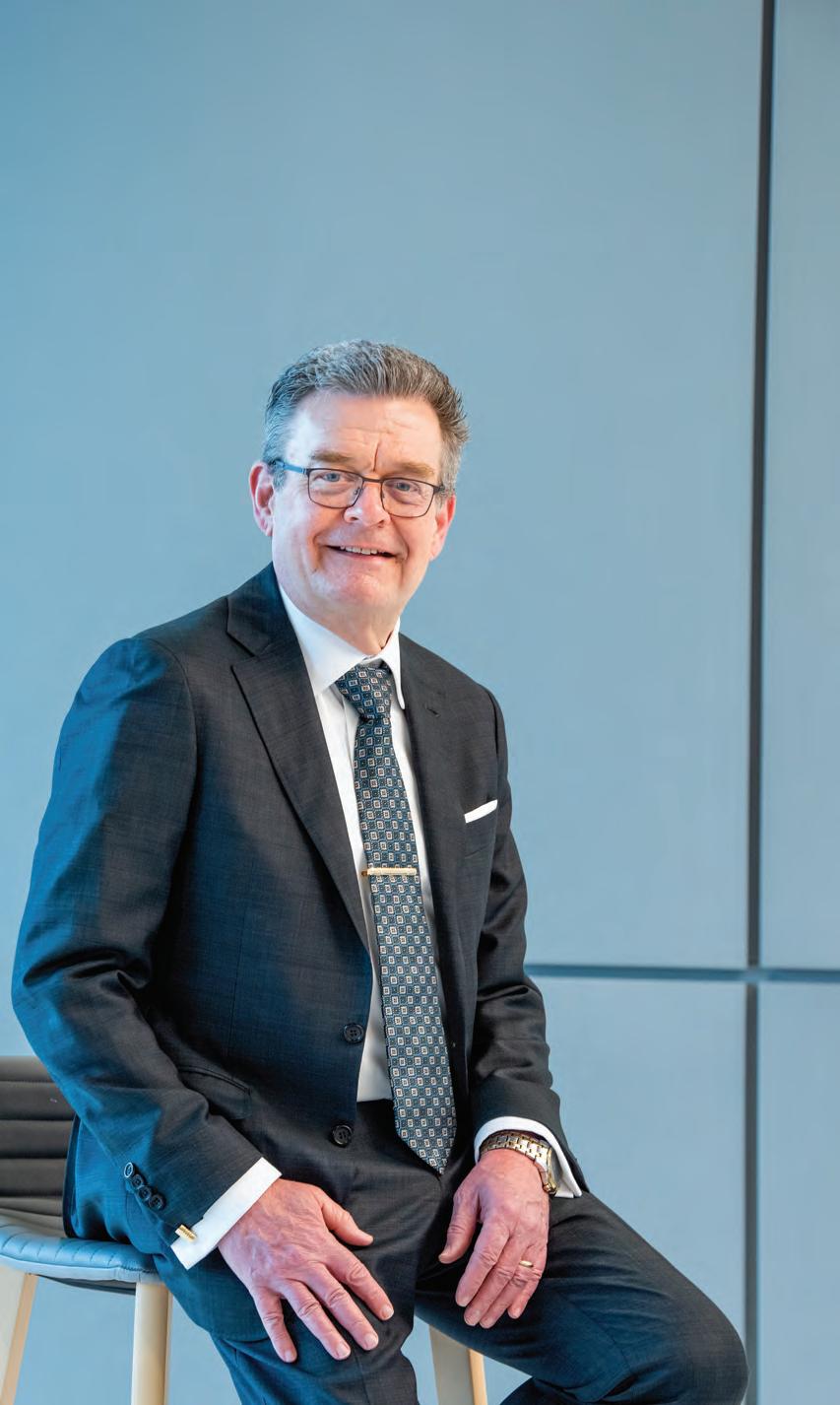
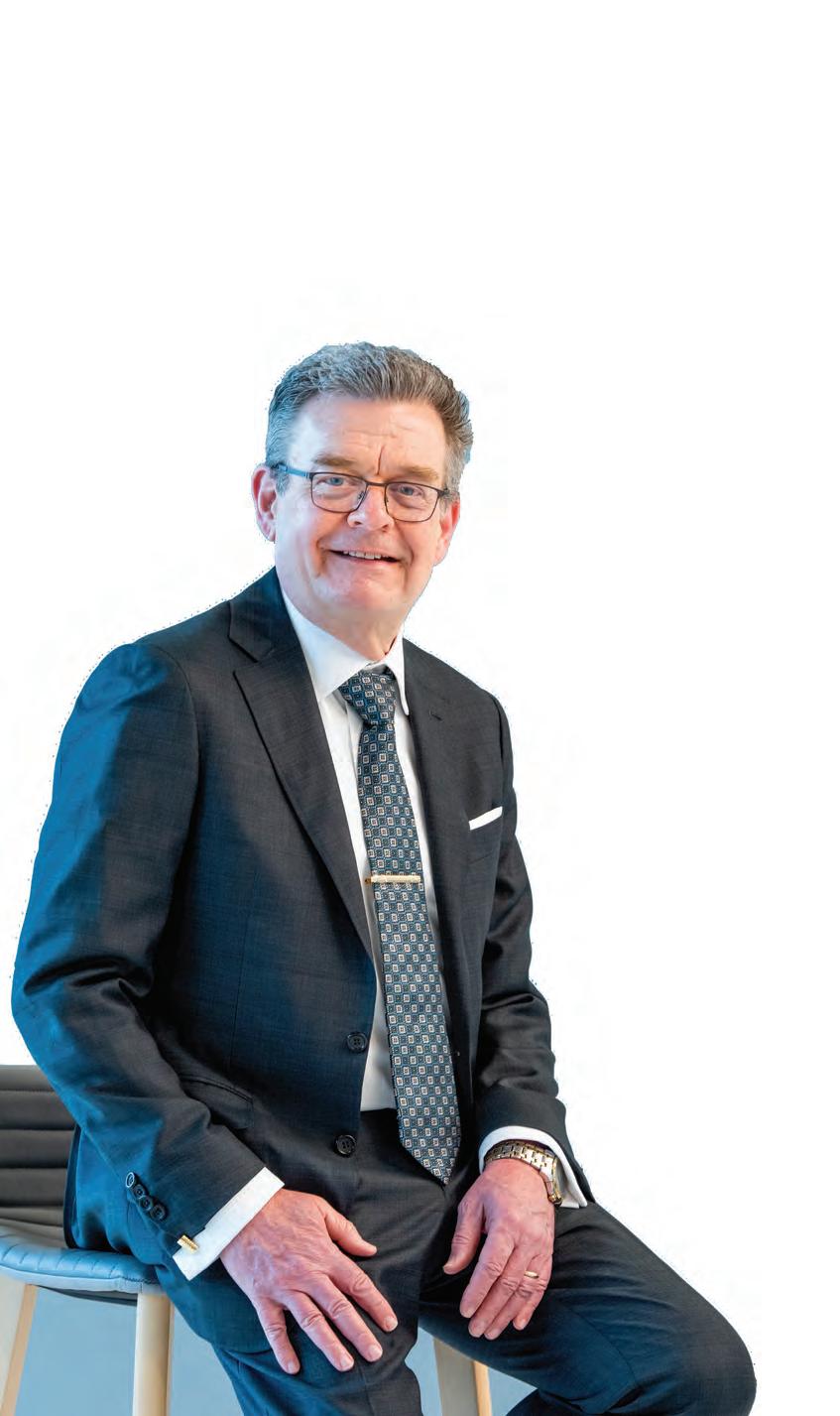
4 Spring 2024
Malachowsky Hall began as a concept that differed from previous projects, an opportunity to intertwine disciplines and interests around an emerging area of significance and importance. It required collaboration among stakeholder groups, all focused on creating something much bigger than the sum of the parts. It required resources and investment from donors, the university, and the state, all of whom recognized the value in this endeavor. It required perseverance, as design and construction straddled a global pandemic, supply chain obstacles, and the challenge of merging innovative function with iconic architecture. It required leadership, from within the university, within our governing board, from a host of external partners who would accept nothing less than excellence from beginning to end.
To this end, UF succeeded.
We had barely opened the building for occupants when the unique attraction of Malachowsky Hall became evident. Students sought it for study space. Faculty pursued it for workshops and conferences. Leadership across campus sought it for special events hosting distinguished guests. Why all the excitement over a building focused on data and information technology? Simply put, it inspires excellence.

In the words of Mori Hosseini, chair of the UF Board of Trustees, “This building will not only advance the future of science, it is a symbol of what is possible when universities relentlessly focus on a future that is brighter.”
With our commitment to make a difference in the lives of others through discovery, innovation, education and outreach, the University of Florida seeks to inspire the excellence that lies within each of us, within the faculty, students and staff who claim UF as their own. It is a privilege to be part of a community that seeks to change the world every day. Indeed, Malachowsky Hall embodies the ambitions of an institution that seeks to create a tomorrow that is better than yesterday, a community intent on making a difference near and far, a university that seeks to inspire excellence always.
 David P. Norton Vice President for Research
David P. Norton Vice President for Research
ExplorE 5
ExplorE 5
UF neuroscientist uses AI to map learning, decision-making to discover how brains work
With trial and error, repetition and praise, when a puppy hears “Sit!” they learn what they’re expected to do. That’s reinforcement learning, and it’s a complex subject that fascinates neuroscientist Ryoma Hattori, Ph.D., who recently joined The Herbert Wertheim UF Scripps Institute for Biomedical Innovation & Technology.
Hattori focuses on understanding and mapping reinforcement learning and how the brain integrates information to make decisions. He also studies how the brain comprehends numbers. What seems simple on its face is actually stunningly complex. The human brain has approximately 86 billion neurons, which make more than 100 trillion connections.
Hattori says many factors play into the decision-making process. Something as simple as deciding where to eat may involve a matrix of memories and judgments, and hence, many areas of the brain. One restaurant has good food and service, another, so-so. One has higher prices, another is cheaper. Experience provides the inputs that must be assigned values and considered for the decision to be made.
“It’s very difficult to integrate all of these processes, and yet, somehow, our brains do that,” Hattori says.
Understanding the mechanisms that underlie this process may prove
important in addressing psychiatric and autism spectrum disorders, he notes.
“Many psychiatric diseases and neurological disorders feature some impairment in decision-making,” he says.
Modeling how multiple brain areas interact to process reinforcing experiences and guide decision-making is an interesting challenge, he says. Hattori uses many research techniques to gather data, including large-scale 2-photon imaging, virtual reality-based experiments, and optogenetics, a method for using light to manipulate neural activity. Computational modeling is increasingly a valuable tool to understand complex animal behaviors and brain dynamics, Hattori says.
Hattori and colleagues are developing artificial intelligence to assist with their research. It’s a two-way relationship: AI helps advance the neuroscience discoveries, and the neuroscience discoveries may also help improve the AI.
“Both the brain and AI are made of neural networks that perform computations and learn using neural activity dynamics and synaptic plasticity,” Hattori says. “They receive external inputs, process the information and output an action. Then, the outcome of the action guides the learning by the network. The similarity gives us an opportunity to use AI as a neural network model for certain behaviors.”

Hattori recently moved to The Wertheim UF Scripps campus in Jupiter, Florida, following a postdoctoral fellowship at the University of California, San Diego. He earned his doctorate in molecular and cellular biology at Harvard University in 2016.
An assistant professor in the institute’s neuroscience department, he’s also a recipient of many awards, including the Warren Alpert Distinguished Scholar award and the Simons Foundation SFARI Bridge-to-Independence award.
His wife is a neuroscientist as well, Mariko Hattori, Ph.D. She recently joined the lab of Kirill Martemyanov, Ph.D., chair of the neuroscience department, as a postdoctoral researcher. The Hattoris have a 15-month old son, and enjoy taking him to the ocean when they’re not in their labs.
The Jupiter community has become a great magnet for neuroscientists, they said. The Wertheim UF Scripps’ strong program is joined by the neighboring Florida Atlantic University Stiles-Nicholson Brain Institute and the Max Planck Florida Institute for Neuroscience.
The Hattoris collaborated with Max Planck’s scientific director, Ryohei Yasuda, Ph.D., on a recently published Nature Neuroscience paper about the role of a brain region called the orbitofrontal cortex in the acquisition of generalized knowledge.
The scientists found multiple layers of learning at work in mouse adaptation to new environments, with different time scales. The mouse learning mechanisms resembled those of a computer model of reinforcement learning that was developed by AI researchers.
“We can gain insights into brain mechanisms from AI. Also, as we better understand the brain mechanisms for decision-making and learning, we may be able to transfer the knowledge to AI models,” Ryoma Hattori says. “I hope my research projects contribute to understanding of the brain, and also contribute to development of AI with better performance in the machine learning community as well.”
Stacey DeLoye
6 Spring 2024
Ryoma Hattori

Supercomputer’s “hero run” looks at molecules of life
By harnessing the full power of the HiPerGator supercomputer, UF researchers are closer to understanding the formation of the building blocks of life.
All life on Earth is built from four types of molecules: proteins, carbohydrates, lipids, and nucleic acids. But could these “molecules of life” form naturally in the right environment? Researchers at the University of Florida are using HiPerGator t he fastest supercomputer in U.S. higher education to test this experiment.
HiPerGator w ith its AI models and vast capacity for Graphics Processing Units, specialized processors designed to accelerate graphics renderings is transforming the molecular research game. Until a decade ago, conducting research on the evolution and interactions of large collections of atoms and molecules could only be done using simple computer simulation experiments. The computing power needed to handle the datasets just wasn’t available.
It is now, thanks to HiPerGator. Using the supercomputer, UF Ph.D. student Jinze Xue in Dr. Adrian Roitberg’s Computational Chemistry Group was able to conduct a large-scale early Earth chemistry experiment during the
2023 winter break. Xue performed a molecular dynamics experiment on 22 million atoms that identified 12 amino acids, three nucleobases, one fatty acid, and two dipeptides.
“Our previous success enabled us to use machine learning and AI to calculate energies and forces on molecular systems, with results that are identical to those of high-level quantum chemistry but around 1 million times faster,” says Roitberg, a chemistry professor who has been using machine learning to study chemical reactions for six years. “These questions have been asked before, but due to computational limitations previous calculations used small numbers of atoms and could not explore the range of time needed to obtain results. But with HiPerGator, we can do it.”
Dr. Erik Deumens, the senior director for UFIT Research Computing, explained how this full takeover of HiPerGator was possible.
“HiPerGator has the unique capability to run very large ‘hero’ calculations that use the entire machine, with the potential to lead to breakthroughs in science and scholarship,” Deumens says. “When we found out about the work

Dr. Roitberg’s group was doing, we approached him to try a ‘hero’ run with the code he developed.”
The project is part of an ongoing effort to discover how complex molecules can form from basic building blocks, and to make the process automatic through large computer simulations. Ying Zhang, UFIT’s AI support manager, ran point for the experiment.
“Ying put together a team comprised of Research Computing staff and staff from NVIDIA to help scale compute runs, provide invaluable advice and help, and accelerate analysis of the data to the point where the analyses were done in just seven hours,” Roitberg said.
“Having HiPerGator in-house with the incredible staff willing to go above and beyond to help researchers produce groundbreaking science like this is something that makes my non-UF colleagues very jealous.”
Tracy Gale
ExplorE 7
Adrian Roitberg
Listening to nurses

When babies from Florida’s Panhandle kept showing up with similar heart defects, UF Health Shands nurse Alexandria Owens knew something was not right.
“We’d hear about a patient being transported from the Panhandle. A lot of the nurses on the unit would talk about the clusters of the patients we’d get from that region with single ventricle defects, specifically hypoplastic left heart syndrome. We’d wonder if the incoming patient was another, similar patient,” said Owens, a charge nurse in the pediatric cardiac ICU and a Ph.D. student at the UF College of Nursing.
Owens wondered if the cases were related to PFAS, chemicals once used extensively, including in firefighting foams. The same foams were used at military installations in the Panhandle and across the country. She wondered if these babies had PFAS in their blood.
But she had no way to find out, until 2022 when UF Health and the UF College of Nursing announced funding
for research demonstration projects submitted by teams of bedside nurses paired with College of Nursing faculty.
Angela Starkweather, assistant dean for research development at the college, hoped they would get at least two good submissions. They got two dozen.
“Nurses have a lot of passion for what they do. This project gave them a voice so they could improve patient care. This effort has been a model across the nation for other colleges of nursing and other hospital systems,” she said.
Other projects included identifying and developing treatments for COVID19 skin wounds and developing monitoring systems to prevent patient falls. The initial one-year demonstration projects have ended, but eight new projects were recently approved, including from the UF Health Jacksonville campus, Starkweather said.
For Owens, the project is just the beginning. All 120 samples from babies tested positive for at least one type of PFAS chemical. The chemicals do not
degrade, and the heart defects are so severe that many of the babies will eventually require heart transplants.
“The next step is to narrow the data. Find out if there are any correlations with parents’ job status, demographics. See if we can identify this as a true cause, and then we can start on preventative measures,” said Mike Maymi, clinical assistant professor, who was co-investigator with Owens on the project.
Owens was thrilled to be heard.
“It’s validating. I think that nursing has been tough, especially the last four years. People are leaving the bedside and leaving nursing. My experience has really reinvigorated my passion for environmental health and critical care nursing as a whole,” she said.
Carlos E. Medina
8 Spring 2024
Alexandria Owens
Decongestant debunked
Decades of research by University of Florida pharmacists Dr. Leslie Hendeles and Dr. Randy Hatton led a Food and Drug Administration advisory panel to vote unanimously last fall that a popular decongestant in over-thecounter cold medicines is ineffective.
Phenylephrine has been a widely used nasal decongestant appearing in more than 260 over-the-counter products in the U.S., but its effectiveness has always been a subject of debate.
Hendeles and Hatton spent years educating pharmacists, health care providers and the public that phenylephrine is ineffective when taken orally because enzymes in the gut inactivate it.
The pair filed multiple citizen’s petitions, testified before advisory committees and pressured the FDA to review the safety of phenylephrine u ltimately leading the FDA’s Non-Prescription Drugs Advisory Committee to vote 16-0 in September that oral phenylephrine doesn’t work as a nasal decongestant.
Hendeles, a professor emeritus, and Hatton, a clinical professor, fielded dozens of media requests following the decision, with their work mentioned in the Wall Street Journal, the New York Times, Time and NPR. On CNN, the decision was named one of Dr. Sanjay Gupta’s top 10 health and wellness stories of 2023.


New words for election year
BIRG CORF VS
Are BIRGing or CORFing part of your media diet?
UF College of Journalism and Communications doctoral student Eliana DuBosar and Associate Professors Jay Hmielowksi and Myiah Hutchens looked at media use after the 2004, 2012 and 2020 U.S. presidential elections to test whether those who backed the winning candidate “bask in reflected glory” (BIRG) by consuming more media about the win, or if members of the losing party “cut off reflected failure” (CORF) by avoiding media coverage.
The survey data showed that those who backed the winner engaged in
BIRGing, but did not show evidence of CORFing after a loss.
“The results revealed that people seek out supportive information when their preferred candidate wins an election. Moreover, we found evidence that this effect was stronger among liberals and Democrats who thought Biden would win the 2020 election,” the authors wrote.
Their article “Celebrating Wins, Lamenting Losses in the Aftermath of Presidential Elections” was published in the Journal of Media Psychology
ExplorE 9
Leslie Hendeles, left, and Randy Hatton, have researched the ineffectiveness of oral phenylephrine for decades, as this photo from 2006 illustrates.
Sea otter success offers conservation lessons coast-to-coast

The return of sea otters to their former habitat in a Central California estuary has slowed erosion of the area’s creekbanks and marsh edges on average by 69%, UF researchers have found.
The resurgence of these charismatic marine mammals a lso some of the habitat’s top predators to the saltmarsh-dominated Elkhorn Slough in Monterey County marks a significant ecological success story.
“This is a solutions-oriented paper that tells us there are manageable actions we can take to produce positive results,” said Dr. Christine Angelini, one of the study’s authors and director of the Center for Coastal Solutions at UF. “In this instance, restoring the otter population was achievable without significant effort, and as a result, we are now unlocking several decades of benefits from that one act of conservation.”
Former Research VP Win Phillips dies at 83
Win Phillips, a longtime UF leader known for his depth of knowledge of the university, versatility and thoughtful advice to the many people who sought it, died February 24. He was 83.
Phillips, who arrived at UF in 1988 as dean of engineering, served in several different leadership positions before retiring in June 2023. He was highly regarded for his proficiency as a generalist, able to take the reins and push forward whatever he was overseeing, while always focusing on the greater UF and its rise as a top public university.
“Win had a saying that he shared with many people over the years when they sought out his counsel for big decisions: As long as you always do what’s best for the university, you can’t go wrong,” said Mori Hosseini, UF Board of Trustees chair. “That was Win he was selfless, always willing to step in and fill whatever role he was needed in, and always willing to do what was best for the university. He was pivotal in making UF the great institution it is today.”
UF President Ben Sasse echoed Hosseini’s sentiments.
“Win Phillips’ passion for UF was obvious, and he was known for his deep grasp of many dimensions of this
incredibly complex institution from academic excellence to research to tech commercialization to student life. He spent his career helping to make UF a leading university. Gator Nation is grateful for his service.”
Phillips spent 11 years as dean of what is now the Herbert Wertheim College of Engineering before becoming vice president for research in 1999.
President Bernie Machen, who served from 2004 to 2014, said his goal at the start of this tenure was to increase UF’s research productivity. Phillips advised that the best first step was to build major new research facilities. That advice, Machen said, led to the construction of several major new facilities including the Cancer and Genetics Research Complex creating cutting-edge space for new faculty and ultimately contributing to the rapid growth of sponsored research at UF.
“The development of our research productivity was a multistage process, but it starts with Win’s analysis that we didn’t have enough infrastructure to support it,” Machen said.
David Norton, who succeeded Phillips as vice president for research, called his predecessor “a great mentor and friend.”
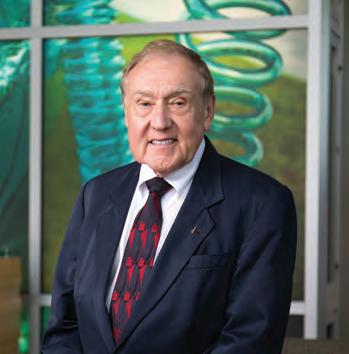 Win Phillips
Win Phillips
“Dr. Phillips created a model for growing and managing the university’s research enterprise that I have tried to emulate,” Norton said. “Much of the progress we have made over the last decade has been as a result of the foundation Dr. Phillips built.”
Among the other roles in which Phillips served are senior vice president and chief operating officer; senior advisor to the president; and executive chief of staff in 2015. He also served stints as interim vice president for university relations and interim vice president for student life.
10 Spring 2024
Findings show that the erosion of creekbanks and marsh edges in areas with large otter populations has slowed, mainly because of the sea otters’ insatiable appetite for plant-eating marsh crabs and at a time when rising sea levels, elevated nutrients, and stronger tidal currents should be causing the opposite effect.
“It would cost tens of millions of dollars for humans to rebuild these creekbanks and restore these marshes. The sea otters are stabilizing them for free in exchange for an all-you-can-eat crab feast,” said senior author Dr. Brian Silliman of Duke University’s Nicholas School of the Environment.
By documenting for the first time that reintroducing top predators to their former habitat can bring stability to a collapsing ecosystem, researchers raise the question: Could similar results be achieved in ecosystems worldwide?
Angelini said the results are encouraging as Florida’s coastlines face similar threats from sea level rise, intense storms and excess nutrients.
“All these challenges can feel unsurmountable,” said Angelini, an associate professor in UF’s Department of Environmental Engineering Sciences. “This study indicates to us that, if we truly understand the ecosystem and know what levers to pull, we can see significant benefits to the health and stability of these systems.”
To understand the impact the sea otters were having on the landscape, researchers conducted large-scale surveys across 13 tidal creeks, as well as smallscale field experiments at five locations around the estuary over a six-year period. Otters were excluded from some test sites but allowed to recolonize others, using a caging system designed by Angelini.
“As a graduate student in biology at UF, I had been setting up these types of cages and manipulating access to predators and their prey in salt marshes all over the Southeastern U.S., so I had the skill set,” Angelini said. “I’ll never forget building all the cages in the parking lot of the estuary out in California. And all these years later, we now see these amazing results.
“It’s an uplifting story about the benefits of conservation and persistent, longterm research.”
For video about this study, visit the @uf.research Instagram.
Karen Dooley
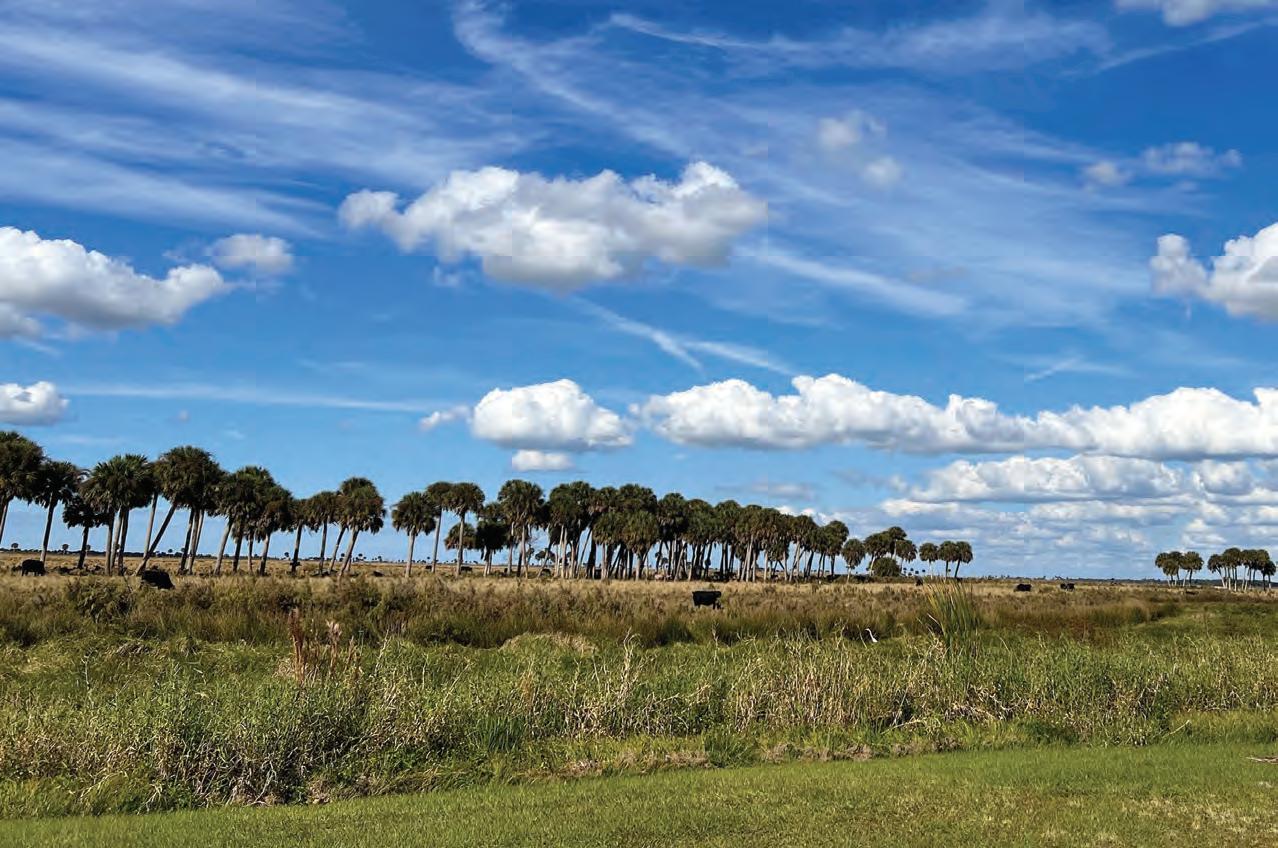
Study focuses on impact of ranching on grasslands and wetlands
A UF/IFAS-led study based on more than 11,000 field measurements made between 2003 and 2020 at the Archbold Biological Station Buck Island Ranch in the headwaters of the Everglades one of the state’s largest working cattle ranches found that while ranching and other agricultural activities in grasslands and wetlands can enhance forage quality and livestock production, it comes at the cost of lower water quality, higher methane production, less resistance to non-native species and reduced biodiversity.
ExplorE 11

Targeting
12 Spring 2024
RNA
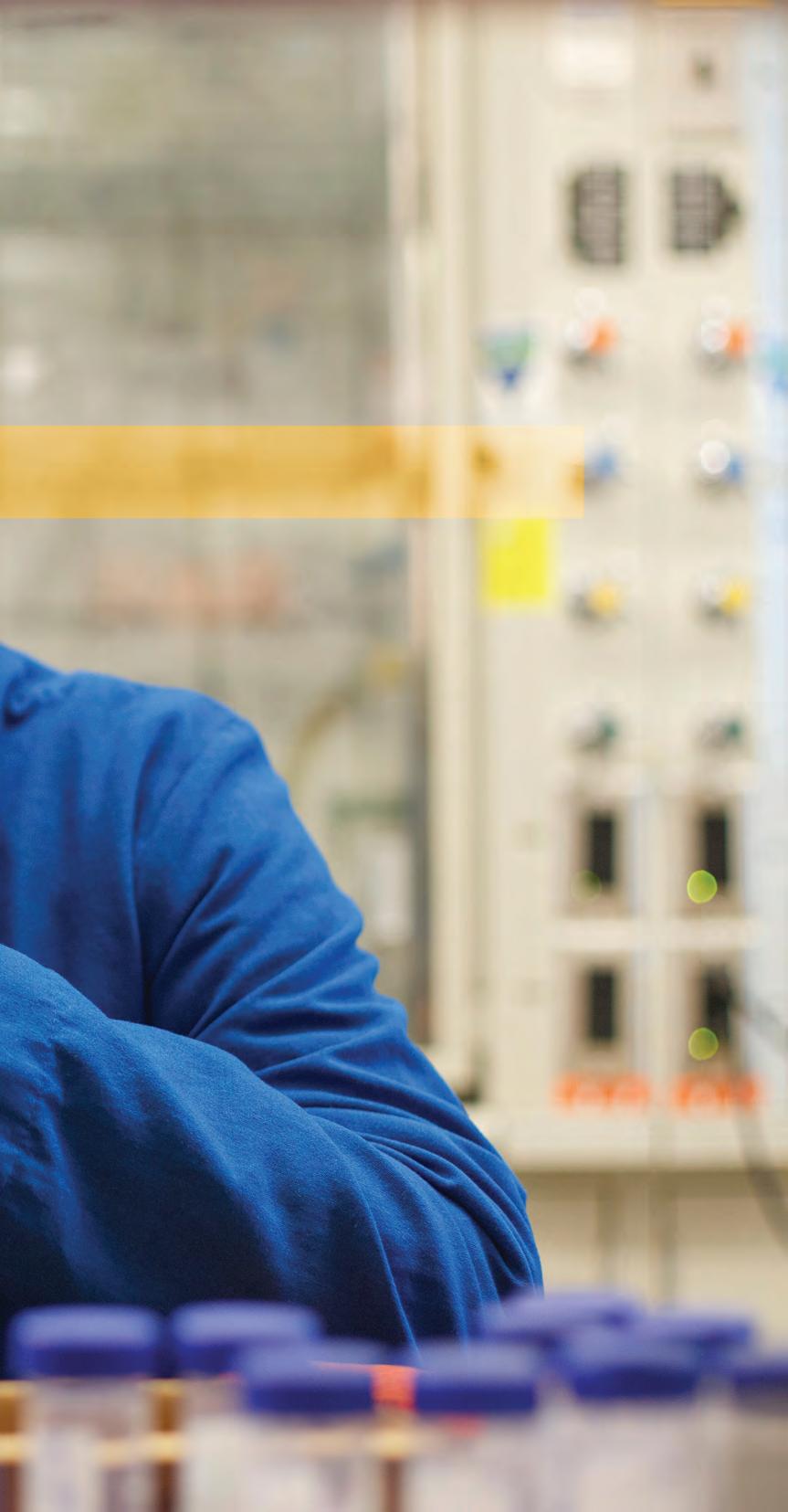 Chemist Matthew Disney is leading a
Chemist Matthew Disney is leading a
revolution in drug discovery
by Stacey DeLoye
in June 2000, when President Bill Clinton announced that the initial sequencing of the human genome had been completed, it was hailed as a milestone in medicine, promising cures for everything from Alzheimer's and Parkinson's to diabetes and cancer.
But Matt Disney had questions.
The teams sequencing the human genome had focused on DNA, counting only about 30,000 protein-coding genes, about the same number as a mustard plant or a worm. What explained human complexity and diversity if humans had similar numbers of genes to plants and invertebrates?
At the time, Disney was working on his Ph.D. at the University of Rochester, focusing primarily on ribonucleic acid, or RNA, which was thought a nd has now been shown to make up 90% of the genome.
Disney thought the answers to his questions about the human genome project, and its real potential, might lie in the RNA. But in 2000, RNA’s structure and functions were still something of a black box, and the idea of making medicines targeted to RNA was rejected as unfeasible, too risky or both.
The gaps in knowledge enticed Disney, who saw translating genetics into treatments as a worthy challenge.
“I thought, well, if we could really turn the human genome and the RNAs that they make into new targets for medicines, that would be transformative.”
Two decades later, Disney and his team at The Herbert Wertheim UF Scripps Institute for Biomedical Innovation & Technology in Jupiter, Florida, have discovered more than 200 unique RNA-targeting compounds. His methods and discoveries have changed minds, igniting a global race to treat incurable diseases via their RNA.
ExplorE 13
Photos by Scott Wiseman 13

Incubator for Discovery
Disney’s drive to discover started early.
As a young boy, he bought himself a telescope. He loved to look at the stars, and he would fill his free time at the library, reading about them. With six brothers and sisters, their downtown Baltimore house was often crowded and loud. The library and the telescope were zones of peaceful contemplation.
“I used to look up at those stars and wonder what those things were made of. Looking at the sky I realized how much we did not know,” he recalls. “My desire to want to understand things made me want to become a scientist.”
He absorbed lessons of hard work and respect from his parents, who devoted themselves to their family. His father served in the U.S. Navy. His mother stayed home with their children early on but later went to work fulltime. At the end of the street was the Catholic school and church that were important parts of his childhood. With a prominent birthmark on his face, he says he learned to stand up for himself early on, too. He didn’t like to be told no.
“If you want Matt to do something, tell him he can’t do it,” his older brother Michael often said. That fierce determination would prove key to his success as a scientist.
As an undergraduate at the University of Maryland, he researched how hydrogen bonds led biological molecules to assemble themselves. In his senior year, his dad drove him to the University of Rochester, to meet an expert in the field, and he soon found himself in graduate school, immersed in working to understand RNA.
The lab’s principal investigator, Dr. Douglas Turner, asked basic questions: What dictated how RNA folded and interacted with other molecules? Were there rules to be gleaned?
RNA is a molecule fundamental to life. While DNA holds the blueprint for life, RNA serves as the architect, implementer and regulator of those instructions. It assembles ribosomes, which are essentially protein-building factories, and feeds raw materials into those factories. It can regulate whether and when genes are expressed.

An RNA structure taken from a toxic piece of genetic sequence that causes myotonic dystrophy type 1, a type of muscular dystrophy. Disney lab
14 Spring 2024
Matthew Disney explains details of RNA chemistry to a graduate student and intern in his lab at The Wertheim UF Scripps Institute in Jupiter, Florida.
“ I used to look up at those stars and wonder what those things were made of. Looking at the sky I realized how much we did not know. My desire to want to understand things made me want to become a scientist.”
— Matthew Disney
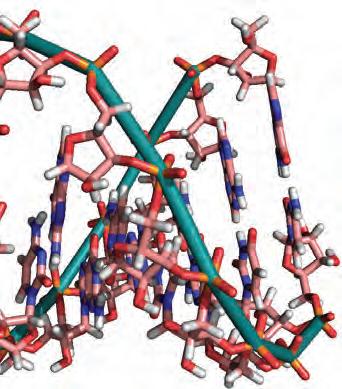

ExplorE 15
Turner’s lab was an incubator for students interested in the potential of RNA. The lab was collaborating with Michael Zuker, a prominent mathematician at Washington University in Saint Louis and Rensselaer Polytechnic Institute, who was writing a computer algorithm that could learn from the RNA folding data and use it to predict the shape and stability of RNA structure based on an input of genetic sequence. The Turner lab students spent long hours with pipettes gathering the data to illuminate the rules that governed RNA structure.
Another student from Turner’s group, Philip Bevilacqua, now head of Penn State’s chemistry department and its Center for RNA Molecular Biology, recalls how Disney put together all that they were learning, creating something new.
“He looked at the diversity of RNA and realized that it could be drugged specifically by small molecules,” Bevilacqua says. “What I admire most about Matt is his vision. Matt was able to see things others could not.”
Another student in the Turner lab was Jessica Childs. Their intense conversations continued through days and nights, weeks and months.
“I think in outlines. Matt thinks like a web,” she said. “He’s creative. He makes connections.”
Testing the Hypothesis
In 2002, Childs, Disney and Turner successfully used small pieces of RNA to fatally disrupt the function of a fungal RNA. Although they didn’t have a medicine, the results convinced them of the feasibility of targeting RNA for therapeutic purposes.
By the time he earned his doctorate in 2003, Disney believed that creating so-called small-molecules medicines that could be taken as a pill would be critical if RNA was to be taken seriously as a therapeutic target. But, he needed to learn more about drug discovery and design.
He moved to the Massachusetts Institute of Technology as a post-doctoral researcher, where he learned critical drug discovery skills. After his post-doc, as he was applying for faculty positions, Disney repeatedly heard why his plans wouldn’t work. Other scientists doubted that drugging RNA was viable due to its simplicity and noodle-like lack of structure.
Most drugs act on proteins, which are large and complex, made of 20 amino acids. RNA, made of just four bases, was too simple to bind drugs, he was told. And if it did, such drugs couldn’t be specific enough to be safe, they said.
He was turned down four consecutive times for grants from the National Institutes of Health.
He was finally offered a faculty position at the University at Buffalo. He went to work creating libraries of RNA molecules and testing them against libraries of small molecules, searching for needles in haystacks. Still, winning grants, getting papers published, proved difficult.
“We’d get feedback, ‘Can’t make that specific.’ So I would say, let’s test the hypothesis. They would say, ‘Can’t make
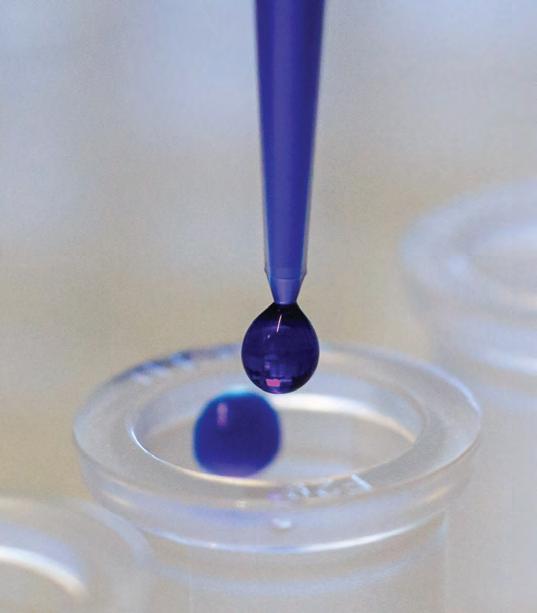
these things bioactive.’ I would say, let’s test the hypothesis. ‘Can’t get this to work in an animal.’ Ok, let’s test it in a mouse. ‘Molecules are too big to get into tissue.’ Let’s see what we can do.”
Over time, painstakingly, he built libraries of compounds, and libraries of RNAs, and designed experiments to rapidly test them against each other. When the arrays would reveal a molecule that bound tightly to an RNA, they’d find out where in the human genome that RNA resided. One day, they realized they had a molecule linked to a devastating form of muscular dystrophy with no cure.
“I was like, ‘Oh! This is going very rapidly from a basic science study to something that might help human beings!’” Disney says.
They published paper after paper. They worked to scale up their system to search for small molecules for any diseases that were labeled incurable due to “undruggable” protein targets.
Thanks in part to Disney and others, the idea of treating diseases by targeting RNA was becoming mainstream. A 2023 biotechnology industry report estimates that by 2028 the value of the global RNA therapeutics market will reach $18 billion.
One day in 2011, Disney received a call from Gerald Joyce, a pioneer of RNA biology who was then at The Scripps Research Institute in California. Scripps had opened a large research campus in Florida, and they wanted Disney to join the faculty.
Disney and Childs, who had married in 2003, were expecting their first child. He had recently been told he would earn tenure. They had stability, but he jumped at the Scripps Florida offer.
16 Spring 2024

The institute was known to be a place of ambition and innovation, and minimal bureaucracy.
“I knew that if I failed at Scripps, the only person I’d have to blame would be myself,” he says.
In Florida, surrounded by other biochemists and RNA scientists, Disney’s work accelerated, and the grants began to flow. Childs, also an expert in RNA chemistry, worked beside him in the lab.
Other potential applications for RNA medicines emerged: the cause of Fragile X syndrome, cystic fibrosis, metastatic breast cancer, Parkinson’s.
Disney and his team found ways to make the potential drugs more specific. They found that binding the RNA target wasn’t always enough to stop the disease progression. So they started experimenting with treating the RNA drug as a delivery system to carry another molecule, one that would act as a beacon to attract existing enzymes that degrade RNA. Over and over, they found ways to address the skeptics’ criticisms.
“It’s always good to have skeptics,” Disney says.
With each major success, the reputation of Disney’s lab grew, and along with it, interest from biotechnology, pharmaceutical and venture capital companies wanting to license his technologies and advance his discoveries.
After Scripps Florida joined the University of Florida in 2022 and was renamed The Herbert Wertheim UF Scripps Institute for Biomedical Innovation & Technology, Disney continued as chair of its chemistry department and became a member of the UF Health Cancer Center. His lab has grown to 21 people, working on grants from the federal government and from private foundations, including the Muscular Dystrophy Association and the Rainwater Foundation.
Disney and his team have invented a search-and-destroy system for multiple incurable diseases. To date, they have discovered RNA-targeting compounds involved in progression of ALS, dementia, types of muscular dystrophy, Parkinson’s,
Disney and his team have invented a search-anddestroy system for multiple incurable diseases. To date, they have discovered RNA-targeting compounds involved in progression of ALS, dementia, types of muscular dystrophy, Parkinson’s, advanced cancers, COVID-19 and several rare diseases.
advanced cancers, COVID-19 and several rare diseases. He has also launched several companies, including Expansion Therapeutics, which is continuing work on his potential treatments for ALS and muscular dystrophy.
The once-scoffed-at idea of treating disease by targeting RNA has become mainstream, thanks, says Penn State’s Bevilacqua, to Disney.
“Matt's disruptive ideas have led multiple other researchers and companies to stand on his shoulders, and we all owe him a debt of gratitude," Bevilacqua says.
At heart, Disney is still that kid in Baltimore looking up at the stars. His Catholic education emphasized finding a vocation, “what you were put on this earth to do,” he says. “I found that in science.”
Matthew Disney
Institute Professor & Chair of Chemistry
Herbert Wertheim UF Scripps Institute for Biomedical Innovation & Technology mdisney@ufl.edu
ExplorE 17
Matthew Disney consults with graduate student Jessica Bush about an upcoming paper on treating ALS with RNA-targeting medicines. Next to them is postdoctoral researcher Haruo Aikawa, a co-author on the paper.
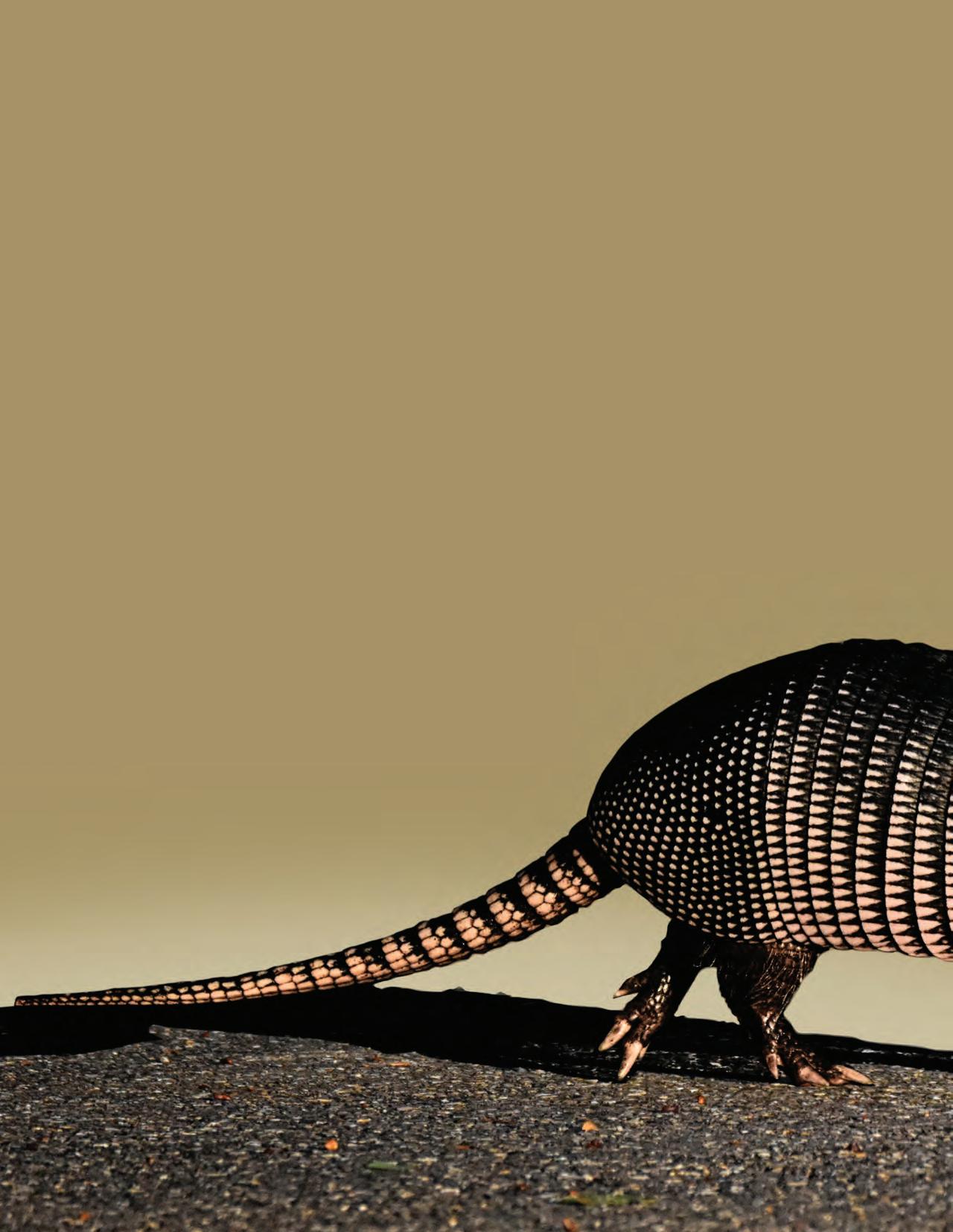

Leprosy is here
A UF team puts science over stigma to stop the spread of Hansen’s disease in Florida and beyond
by Alisson Clark
18 Spring 2024

The man’s skin just didn’t feel right.
He’d been to four dermatologists before traveling to the University of Florida, where he described patches of skin feeling “loose” a lmost dead. The rash that covered his torso and limbs in reddish-purple spots hadn’t responded to the steroids and antibiotics the previous doctors prescribed. Worse, his legs felt hot and swollen, tingling with what felt like electrical shocks, and the loss of feeling in his feet was spreading to his arms.
Despite the fact that the man’s only international travel had been a cruise 15 years prior, his UF Health dermatologists consulted with their colleagues in the Division of Infectious Diseases and Global Medicine. The physicians suspected something ancient Biblical, even.
If you thought leprosy was eradicated long ago, you’re not alone. But each year, more than 200,000 people worldwide are diagnosed with the condition now known as Hansen’s disease, a bacterial infection that can cause irreparable damage if untreated. The United States averages fewer than 200 cases per year, with 6,500 active cases on the National Hansen’s Disease Programs Registry, but Florida has one of the highest rates of infection a nd experts say cases are on the rise here and nationally. In 2023, UF launched a research team to mobilize against humanity’s oldest infection, which remains as shrouded in mystery as it is in stigma. The team aims to tackle both.
“Why does Florida have so many cases of Hansen’s? And are we just the tip of the iceberg?” asks Dr. Norman Beatty, an infectious disease specialist at UF’s College of Medicine who advocated to create the team. “We can really dive into some groundbreaking research here that can be translated to other regions.”
Beatty specializes in what are known as Neglected Tropical Diseases, understudied conditions that the developed world may no longer have the luxury of neglecting.
“As a scientific community, we really have to acknowledge that certain diseases have been put on the back burner, and Hansen’s is one of them,” Beatty says. “As our state continues to change, as our environment and climate changes, diseases like Hansen’s will continue to evolve. Without doing the research that’s needed, we’re not going to understand who’s at risk.”
ExplorE 19
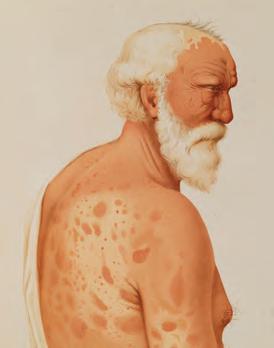


For the patient with the loose-feeling skin, the screening hinged on an unusual question: Had he had any contact with armadillos?
What is Hansen’s disease?
Dr. Kartik Cherabuddi lifted his student’s forearm, tapping it gently with the tip of his pen. The red patch that bloomed there brought him back to his time in medical school in southern India, where he’d seen “more cases of leprosy than I can remember,” he says.
Now he’s seeing cases here.
Luckily for the student, this isn’t one of them. Cherabuddi drew the lesion on the student’s arm with a marker about an hour ago, before a symposium on Hansen’s disease organized by UF’s Emerging Pathogens Institute. Standing at the front of the amphitheater, he demonstrates how to test for the loss of sensation that typifies the disease as the assembled crowd of physicians, researchers, patients and curious members of the public looks on.
Hansen’s takes on average more than eight months to diagnose in the U.S., where leprosy isn’t top of mind for most doctors. It’s highly curable with antibiotics, but the lost time can translate to nerve damage that endures after the infection abates. Like tuberculosis, Hansen’s is caused by a bacterial infection t hey’re even in the same mycobacterium genus. When Mycobacterium leprae takes hold, it not only causes skin lesions but attacks the nerves. That’s the root of leprosy’s association with lost body parts: Once patients can’t feel pain in the affected areas, it’s much easier to get injured and re-injured, especially in vulnerable areas like fingers and feet.
While more than 95 percent of the population is thought to be naturally resistant to M. leprae, throughout history those with leprosy were forced into lifelong isolation for fear of the disease’s spread. Leper colonies aren’t just the stuff of distant lands or medieval tales. In the U.S., admissions to the National Leprosarium in Louisiana didn’t become voluntary until the 1970s, with treatment shifting to outpatient clinics in 1981.
Were these extreme measures necessary? While current knowledge says person-to-person spread requires close, sustained contact, Cherabuddi and Beatty wonder if Hansen’s is actually spread in another way, especially in the U.S. During Cherabuddi’s medical-school rotation in a leprosy clinic, he often saw households with more than one person affected, but that’s not the case in the States. Could the family connection in other countries be due to other factors households share, like soil, water, genetics or nutrition?
20 Spring 2024
M. leprae bacteria
Brianne Lehan
Kartik Cherabuddi at the EPI Hansen’s Disease Symposium
Example of leprosy from dermatologist Prince Albert Morrow, 1889

“I think there is more to the story,” Cherabuddi says. “Even though it’s the oldest infectious disease known to mankind, there’s so much still unknown.”
First, they need a stronger grasp of the disease’s prevalence, Cherabuddi says.
“How common is it in Florida? The scope of the problem is the first thing to understand,” he says. “Everything else flows from there.”
What they already know is that early diagnosis is key to making a complete recovery. At the symposium, Cherabuddi teaches physicians in the audience to look for nodules in cooler areas such as ears that the bacterium prefers and to feel patients’ nerves for the thickening that’s a telltale sign of the body trying to contain the invading bacteria.
That’s what the UF team did for the man who had struggled for years with his mysterious symptoms, noticing that a nerve in his leg was enlarged which brought them back to armadillos, the only known animal host of Hansen’s in the Americas and a possible player in its
spread. Ten years ago, his neighbor had asked for help removing armadillos burrowing under her house. He had obliged.
We had it first
Spare a thought for the armadillo, scratching out an existence in ever-smaller stretches of wilderness, much of it bordering our backyards. Then consider that while armadillos could be giving us leprosy now, we gave it to them first. They even develop the same symptoms. Scientists aren’t sure how leprosy spreads among armadillos or from armadillo to person. They have no idea how many armadillos live in Florida, let alone how many carry M. leprae but in areas like Brevard County, the epicenter of recent cases, testing indicates it could be a quarter of them.
Some Hansen’s patients in Florida have had direct contact with armadillos, like a man who accidentally ran one over with his riding lawn mower. The resulting mess sprayed armadillo blood and bits onto his leg, where he later developed
a lesion that turned out to be Hansen’s. Others may have had exposure to bacteria in the soil through jobs like landscaping, says Dr. Juan Campos Krauer, a UF veterinarian who brings wildlife expertise to the Hansen’s team. An avid gardener, Campos Krauer takes precautions to avoid the bacterium, but when he sees armadillos snuffling around his compost pile, he’s not alarmed.
“They’re essentially harmless,” he says. “They’re also beneficial. They’ll eat spiders, they’ll eat cockroaches. Really, I don’t think people need to go to war with armadillos. Just make sure to wear gloves, or wash your hands thoroughly. Change clothes if you were working with lots of dust and dirt, and change your shoes or at least clean them before going inside.”
In his native Paraguay, the connection between armadillos and leprosy is common knowledge.
“The first day I arrived here in Florida, I started driving and was seeing all these dead armadillos around on the side of the road. I was thinking, wow, it would be
ExplorE 21
Cat Wofford
Dr. Norman Beatty, Dr. Juan Campos Krauer and Dr. Kartik Cherabuddi are part of UF’s Hansen’s disease team.

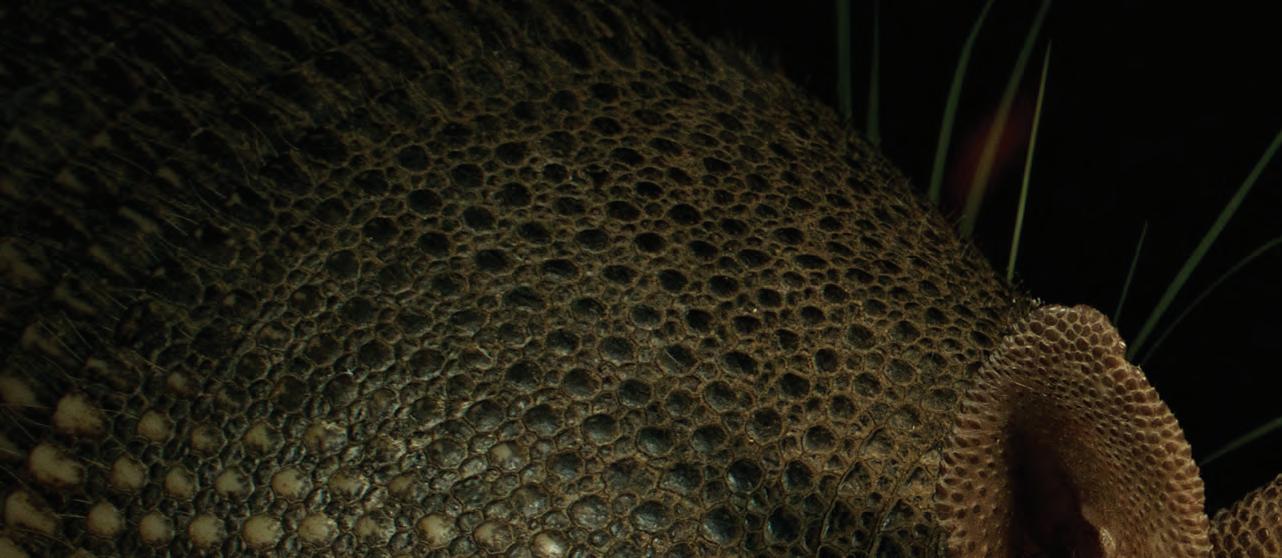

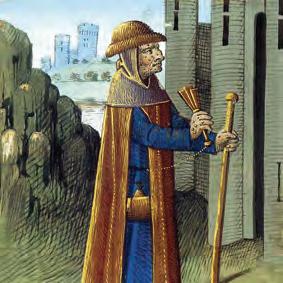
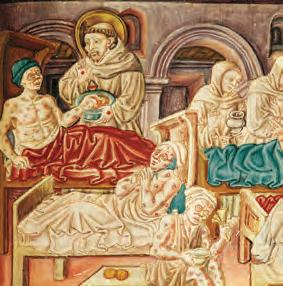
22 Spring 2024
Leprosy through the Ages
A person with leprosy shaking a noisemaker. (Late 15th Century)
St. Francis caring for people with leprosy. (circa 1474)
Dawn Peek
Man in Oriental Costume, Rembrandt; King Uzziah stricken by leprosy. (circa 1639)
“I don’t think people need to go to war with armadillos. Just
make sure to wear gloves, or wash your hands thoroughly. Change clothes if you were working with lots of dust and dirt, and change your shoes or at least clean them before going inside.”
—Juan Campos Krauer

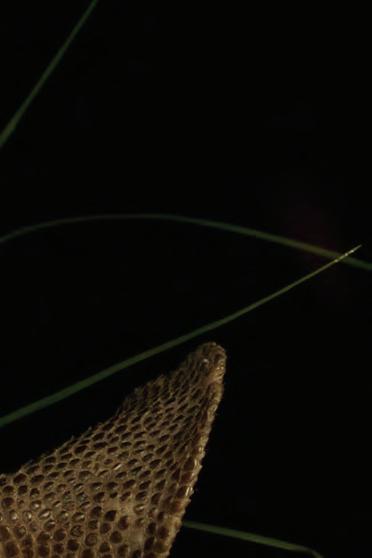

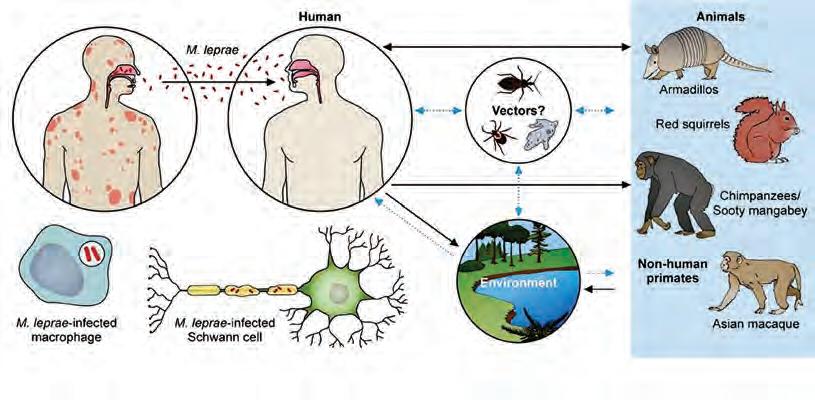
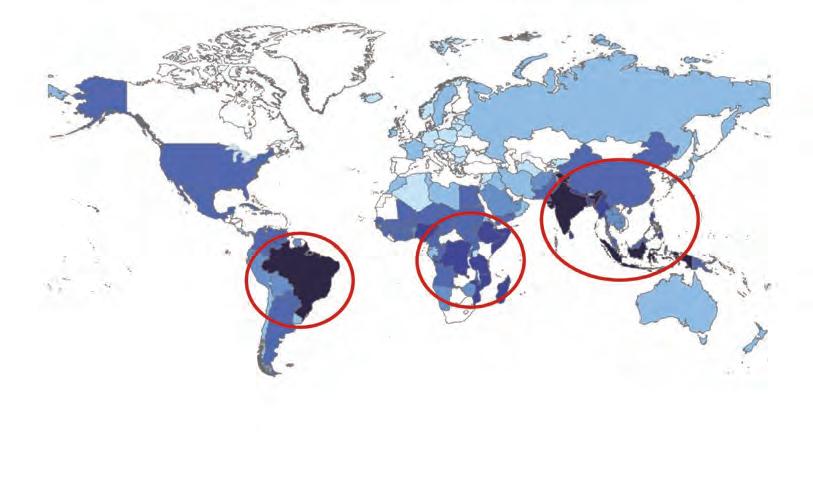

>10,000
No Data
Greater than 200,000 new cases of leprosy are reported each year worldwide. 0 1-10 11-100 101-1000 1001-10,000
Brevard County, in red, had 20 reported cases in leprosy in 2020, while no other county had more than one.
Leprosy Cases in Florida in 2020
ExplorE 23
How Hansen’s Disease Spreads
et
M. Sugawara-Mikami
al.
Virulence.
Tallahassee
Pensacola
Gainesville
Jacksonville
Miami
Cape Coral Tampa
St. Petersburg
Orlando
New leprosy cases, 2020
WHO Leprosy Global Distribution 2021



super interesting to collect these animals and test them to see if they’re positive.”
Now he’s doing just that, in Gainesville and four surrounding counties. He wants to find out how widespread Hansen’s is in armadillos a nd if roadkill can spread it into the surrounding soil and water. After collecting an infected carcass, he’ll place it in a controlled field environment protected from flies and predators, then sample it every six hours for two or three weeks to see how long the leprosy bacillus remains viable. Armadillos tend to stick to the same paths and passageways, and males follow females’ pheromone trails during mating
season. If the bacteria endure after the host dies, that means goop on the roadside could infect more armadillos walking through it. Campos Krauer’s findings can inform control measures, such as barriers in key areas, that could reduce roadkill risk. With enough data, the team can also identify areas of high positivity where such control measures are most needed, he says.
His first challenge: finding carcasses. While there’s no shortage of squashed armadillos, in the race to collect them, vultures often get there first. While vultures are not known as leprosy
hosts other than armadillos, only primates and red squirrels carry the disease C ampos Krauer wonders if the feet and beaks of feasting vultures could spread the bacteria.
“I would love to test vultures, too,” he says, “but that’s more challenging.”
A new strain?
Before you swear off the outdoors, keep in mind: Most people who are exposed to leprosy won’t become ill, and many of those who do likely recover on their own. It’s incredibly rare. So why did UF form a Hansen’s team?
24 Spring 2024
Roodkill armadillos the team finds are tested for Hansen’s, helping to shed light on its prevalence in Florida.
Cat Wofford
Cat Wofford
Cat Wofford
16%
In some parts of Florida, up to of armadillos may carry M. leprae.
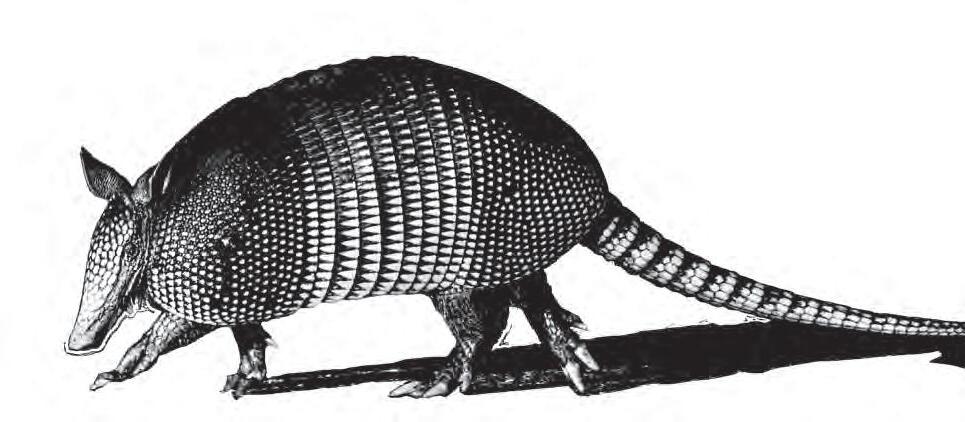
“When leprosy started appearing in the media, people thought there was a sudden change,” Cherabuddi explains. “It’s more a subtle change that’s been going on for a few years now. Once we see escalating numbers of infectious disease, you might see a much larger outbreak later. When an epidemic happens, you see numbers slowly creep up and then there might be an explosive phase. If that’s going to happen, you’d want to be informed beforehand.”
Part of what concerns scientists is leprosy’s leisurely timeline. You could be exposed now, but not develop symptoms for a decade, when it’s hard to remember specific situations where you might have encountered the bacterium. (Unless you liquefied an armadillo with a lawn tractor. Nobody’s going to forget that.) If the cases popping up now originated five or 10 years ago, how many will we see 10 years down the road?
Another challenge: M. leprae has never been successfully grown in a lab. That complicates its study, but not its cure t he right antibiotics will kill it, and if it’s not too advanced, reverse the lesions and nodules it causes. Still, Hansen’s carries a stigma that more-contagious diseases don’t.
With Hansen’s in the headlines and in our backyards, there’s new urgency
to find answers about its spread. Cherabuddi and Beatty hope that UF’s research capabilities, including detailed genetic analysis, can make strides to eradicate the ancient disease.
“What is interesting here in Florida is, it’s impacting a whole wide breadth of folks from different backgrounds and scenarios. We really do not know why certain populations are at risk and why certain populations are becoming infected,” Beatty says. “Who should we be screening? How do we develop programs for access to the care and the testing that’s needed? We really have none of that right now.”
The UF team will look at what makes people resistant to the bacteria. They’ll also study de-identified blood samples to check for antibodies to Hansen’s to estimate how many people have been exposed, and investigate whether those who are infected are transmitting the bacteria within their households, which has never been studied in the U.S. Following the discovery of a second species of leprosy bacterium in Mexico in 2008, Beatty wonders if yet another strain might be causing Florida’s cases. Genetic sequencing can shed light on that possibility, which could inform prevention and treatment, drawing on partners across campus and beyond.
“To tackle a complex disease like this, we need molecular biologists, we need wildlife specialists, we need environmental scientists,” Beatty says. “That’s why I enjoy working at the University of Florida. It’s a culture of team science.”
The UF team found answers for the man with the dead-feeling skin, in partnership with the National Hansen’s Disease Program. It was clear he had leprosy. After a month on anti-inflammatories, he started a regimen of three antibiotics. After six months, his lesions were barely visible. In two years, he no longer had leprosy, but his nerve pain continued.
“Once the nerves are damaged,” says Dr. Nicole Iovine, UF Health’s chief hospital epidemiologist, “it’s permanent.”
The takeaway? Early diagnosis is key. If you have lesions you think could be leprosy, talk to your doctor and steer clear of armadillos.
Norman L. Beatty, MD Assistant Professor of Medicine norman.beatty@medicine.ufl.edu
Kartik Cherabuddi, MD Professor of Medicine kartikeya.cherabuddi@medicine.ufl.edu
Juan M. Campos Krauer, DVM, PhD
Assistant Professor of Large Animal Clinical Sciences and Wildlife Ecology and Conservation jmcampos@ufl.edu
ExplorE 25
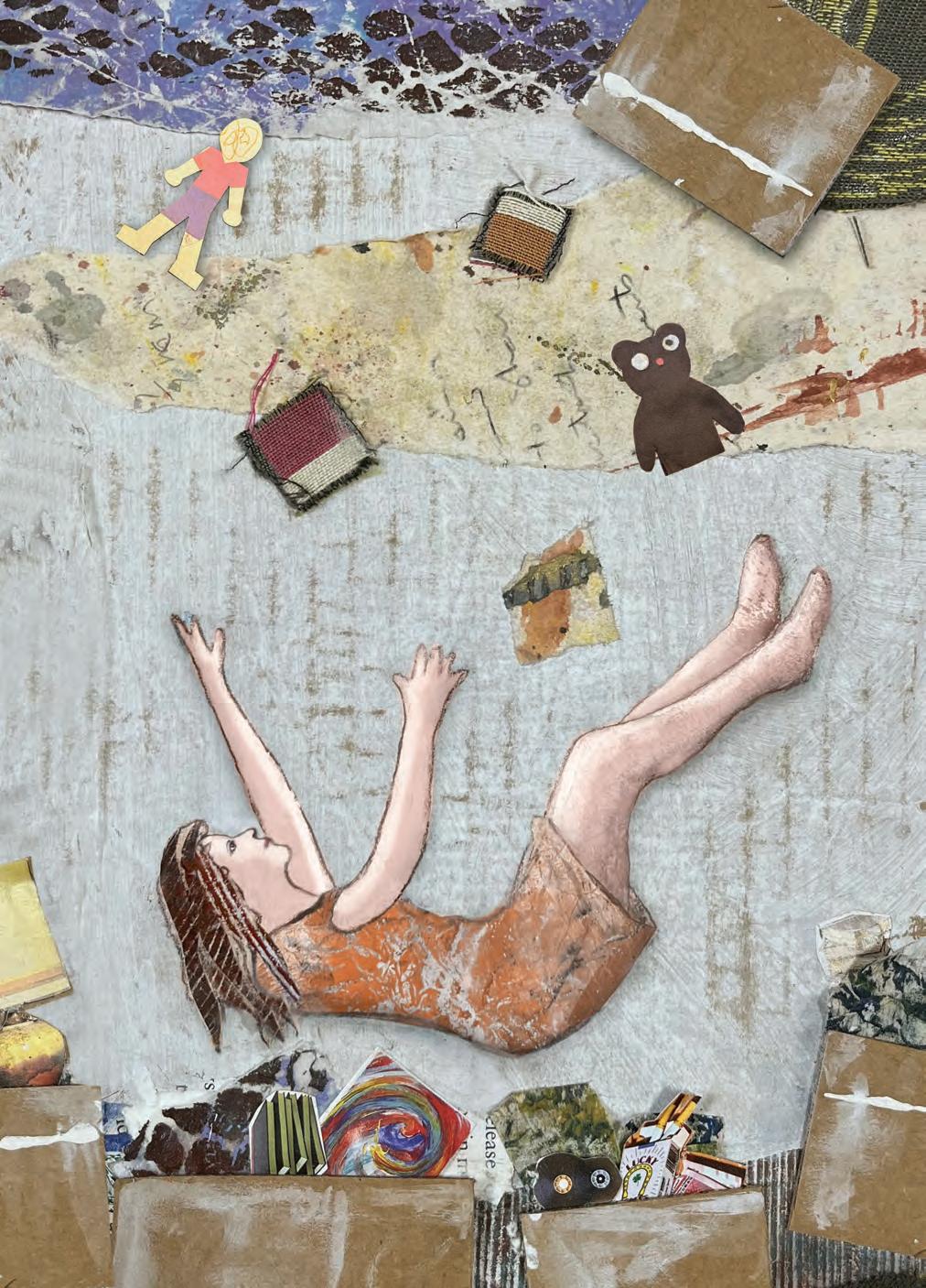
26 Spring 2024
K. Kinsley-Momberger
Unpack ing Hoarding Unpacking
New hope for a disorder that’s about more than too much stuff
by Alisson Clark
Like most physicians, Dr. Carol Mathews keeps educational pamphlets in her office about the conditions she treats. Unlike most doctors, she doesn’t want patients to take them.
“I actually have to tell my patients, ‘You’re not allowed to pick up any flyers in my office. I’ll give you the one that’s relevant. You don’t need all the rest.’”
That’s because they’re seeing her for hoarding disorder, a chronic psychiatric condition marked by an inability to part with items that others might easily identify as unnecessary. It’s one thing to keep your late mother’s hairbrush, but most of us wouldn’t feel the need to keep the hair stuck in it. For Mathews’ patients, though, shedding items can feel like losing part of their identity. In the United States, the newly recognized disorder affects about 4% of adults, rising to 6% of those over 65. Found in every country researchers have studied — even minimalist Japan — hoarding is more prevalent than bipolar disorder, schizophrenia, or obsessive-compulsive disorder, and is linked to falls, isolation, and 25% of deaths from house fires.
“It’s a hidden illness,” says Mathews, a UF Health psychiatrist. “Even people who have it don’t necessarily know it is a medical disorder.”
With support from the National Institutes of Health, Mathews and her collaborators are demystifying hoarding. They’re looking for genetic markers and big-data clues that could help spot the warning signs of a condition that intensifies with age, offering hope for patients, loved ones and caregivers.
Reality vs. reality TV
Christina, 33, glances at the stack of textbooks in her bedroom. She’s been holding onto them for years, and hasn’t needed them once. But what if she needed them in the future?
“I don’t know why I have them, but I can’t get rid of them,” she says. “Just thinking about it now, my chest is tightening up. I’m starting to get sweaty and anxious. So why even try? That’s why you end up drowning in stuff.”
For Christina, who is using only her first name because of the stigma surrounding the disorder, the symptoms intensified after her first daughter was born eight years ago. She got good at hiding the clutter, finding places to stash items she knew she no longer needed, but couldn’t part with. Still, the piles of papers and outgrown baby clothes were taking a toll on her marriage. She had seen reality shows where extreme hoarding cases grapple with eviction, shame, denial. She didn’t want that for herself or her family.
“Hands down, I could see where I would be on the show in another 30 years,” she says.
She turned to Mathews for help.
A fascination with the brain had led Mathews to medical school, where she planned to be a neurosurgeon, but quickly realized that path didn’t offer much opportunity to get to know her patients.
“Being very interested in how the brain works, psychiatry was a logical extension of that,” she says.
ExplorE 27
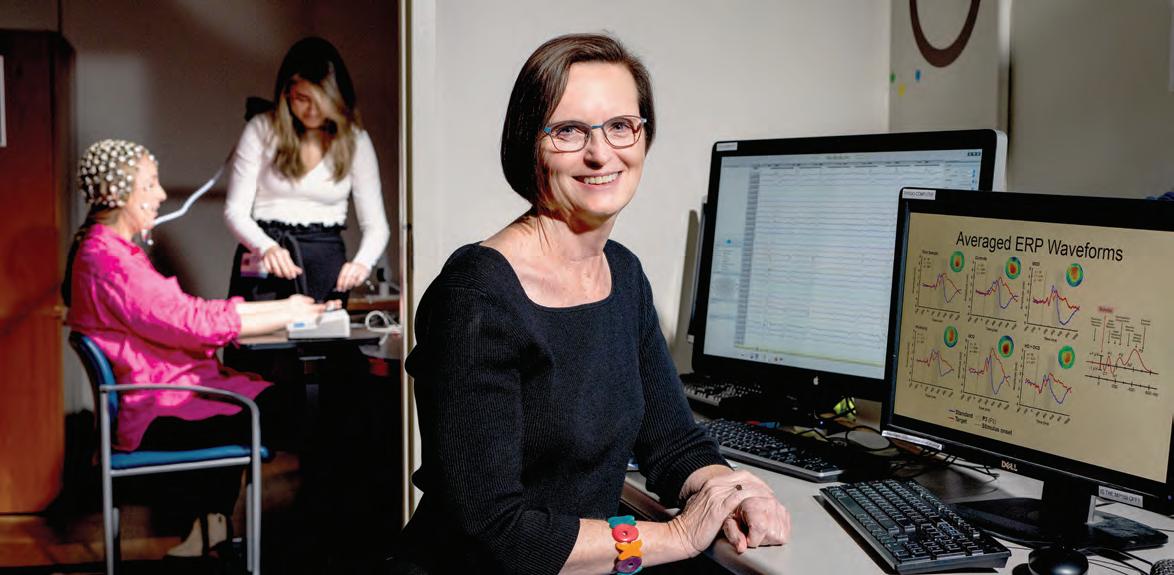
“My favorite thing about being a scientist is when things don’t fit with what you would expect. That’s when the most interesting things come out,” says Carol Mathews. “And with hoarding disorder, my initial hypotheses are almost always wrong.”

“It’s not a feeling of joy, the stuff I have. It’s a feeling of obligation. What if I get rid of it and something bad happens? ”
- Christina


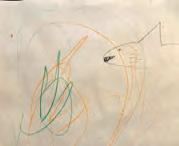

While studying OCD, Mathews noticed that her patients’ hoardings symptoms didn’t respond the way she expected. At the time, hoarding was considered part of OCD. After it was recognized as its own disorder in 2013, Mathews dove into understanding it. With $3.7 million from the NIH and more than $2 million from the Patient-Centered Outcomes Research Institute, Mathews and colleagues at the University of California San Francisco and Massachusetts General Hospital are working toward better diagnosis and treatment.
In an ongoing NIH-backed study, Mathews draws on local patients as well as the Brain Health Registry, an online repository of 54,000 volunteers who share assessment results every six months to aid in clinical trials of age-related disorders. Using symptom and diagnosis data from over 30,000 participants 60 and older, Mathews hopes to predict who may be vulnerable to hoarding later in life, helping patients and families affected by this highly heritable disease.
What qualifies as hoarding?
If you’ve read this far, you might be eyeing an overstuffed closet and wondering about your own tendencies, or thinking of a loved one who long ago gave up on fitting cars in their garage. While hoarding and its risk factors are still poorly understood, one thing is certain: it’s different from simply having too much stuff. It’s also different from collecting, which might look strange from the outside, but makes perfect sense to the collector.
28 Spring 2024
Betsy Brzezinski
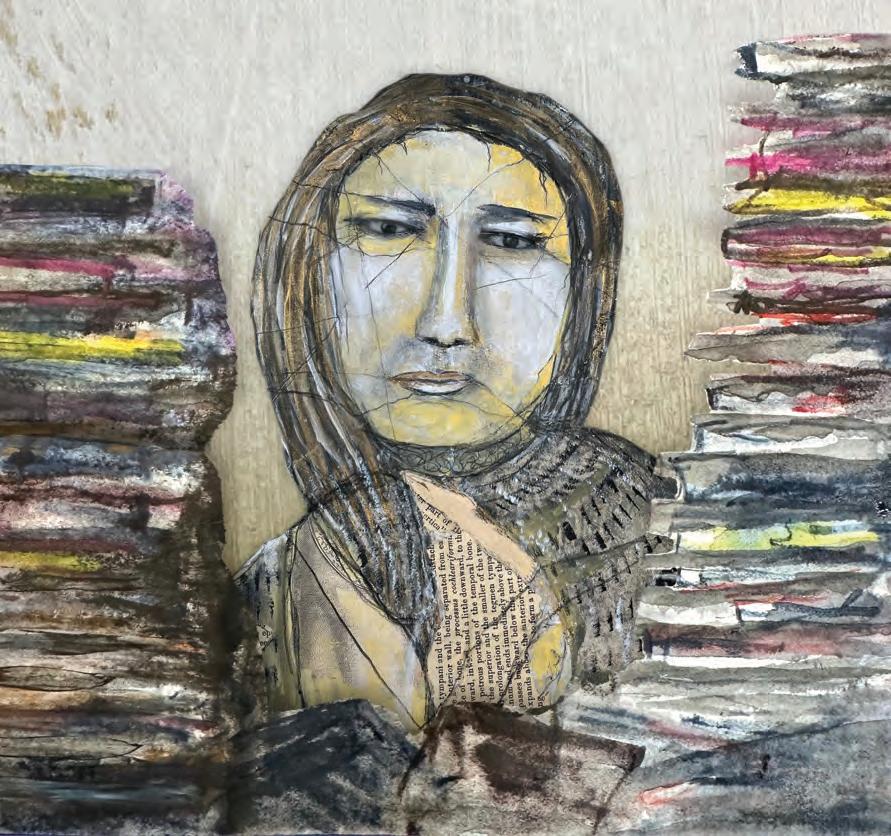
One question helps researchers determine when stuff is more than clutter: Are you unable or unwilling to let someone into your home?
Like Christina’s textbooks, the items people with problematic hoarding amass don’t bring them pleasure.
“It’s not a feeling of joy, the stuff I have,” she says. “It’s a feeling of obligation. What if I get rid of it and something bad happens?”
One question helps researchers determine when stuff is more than clutter: Are you unable or unwilling to let someone into your home? If so, there’s a better than 80% chance you have hoarding disorder, Mathews says. (Other predictive questions: Can you use your bed or kitchen table as intended, or are they partly covered in stuff?)
Because many don’t see their hoarding as a problem, much less a medical disorder, Mathews and her colleagues want to develop other ways to predict who’s at risk. For that, the
researchers turned to math. As part of the NIH study, Luis Sordo Vieira, a UF computational biologist, used the university’s HiPerGator AI supercomputer to analyze data from the Brain Health Registry, which includes 24,000 responses to hoarding questionnaires alongside other longitudinal measures. Using network science, machine learning and artificial intelligence, Sordo Vieira hopes to find ways to screen patients and catch hoarding early, an approach that isn’t usually used because of the small sample sizes typical in psychiatric studies, he says.
“We know so little about mental health disorders and psychiatry as a whole, and yet we have all these large databases coming out,” Sordo Vieira says. “How do we best leverage them to better understand psychiatric disorders?”
ExplorE 29
K. Kinsley-Momberger

Sordo Vieira’s research looks for connections that can help doctors predict who is at risk without asking about hoarding at all. That’s advantageous for three reasons: It avoids the stigma around hoarding; it doesn’t rely on patients or physicians knowing about hoarding as a medical disorder; and finally, it doesn’t add the burden of screening for yet another condition during the brief time doctors get with patients. Mathews and Sordo Vieira have already found correlations to depression and attention-deficit hyperactivity disorder. Sordo Vieira hopes big data analysis could open new pathways in psychiatry for other disorders, too.
“What I’m trying to do is connect these different disorders that are usually thought of as silos,” he says. “These things don’t occur in isolation. Can you look at a patient’s symptoms as a whole and come up with individual therapies? That’s the idea I would like to push forward.”
Bringing hoarding out of hiding
A daughter stands in her widowed father’s living room, where clutter covers every available surface. After a complaint from a neighbor, he’s in danger of having his house condemned. She’s concerned, he’s unmoved. It’s a familiar scene to anyone with a
loved one who hoards, but it’s playing out in the American Airlines Theatre with Danny DeVito.
DeVito and his real-life daughter Lucy co-starred in the Broadway play “I Need That,” which closed in December. Mathews didn’t see the play, but she’s intrigued: Could this be an indication that hoarding is moving out of the shadows? Because the disorder disproportionately affects older people, its prevalence will likely climb as the U.S. population ages. The nonprofit Population Research Bureau estimates that the number of Americans 65 and over will climb to 82 million by 2050, a 47% increase from 2022. Add in the millions of caregivers and loved ones affected, and the disorder suddenly seems like a public health issue, not a fringe fascination on reality TV.
For those wondering how to help a loved one, Mathews emphasizes that hoarding is treatable. Options include cognitive behavioral therapy where patients learn to discard items and a technique called motivational interviewing that builds buy-in for change. Mathews has also studied peer counseling by those with lived experience in hoarding, which she has shown can be just as effective as professional therapy. Another approach is harm reduction, which can help make homes safer for patients who aren’t ready to reduce their hoards.
Luis Sordo Vieira, whose background is in mathematics and biology, applies tools from data science, math and engineering to psychiatry. By using data to reveal connections between conditions, he hopes to improve screening for hoarding and other disorders.
30 Spring 2024
Betsy Brzezinski
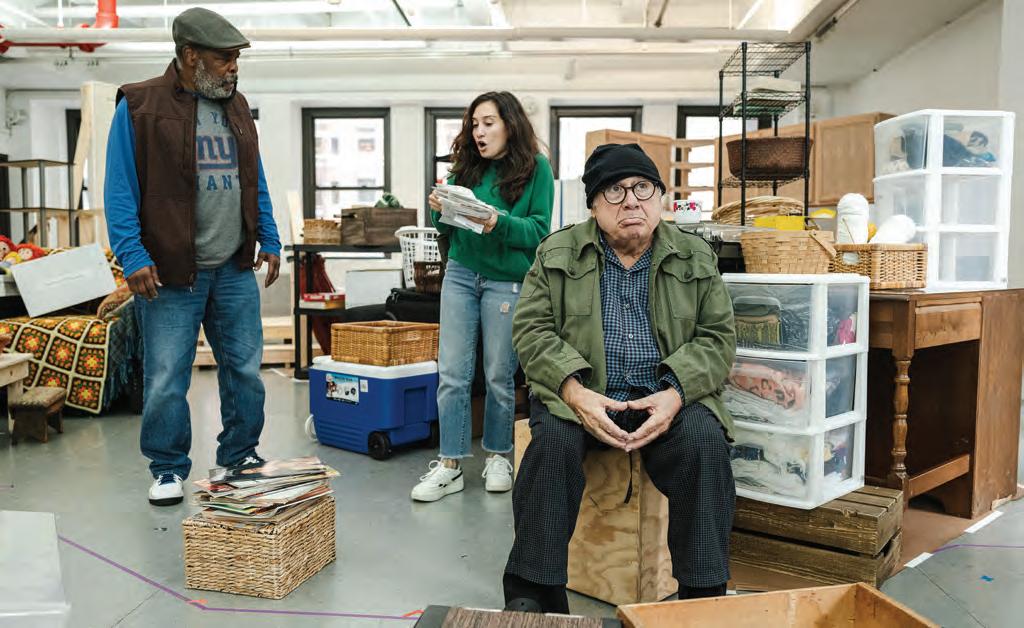
Safe treatment, she is quick to add, never includes the type of forced clear-outs seen on television, which can put patients into crisis.
For Christina, seeing Mathews and other UF doctors has helped her understand that she can part with items without disregarding the meaning they once held. She used to keep all of the papers her daughters brought home from school — not just the adorable art projects, but every single math worksheet. She held onto all of their baby toys and clothes and blankets. To relinquish even one item would have felt like erasing part of their precious childhood. No longer.
“I’ve gotten rid of a ton of things now,” she says. “It’s a process. But it’s like weights that were holding me down are slowly being released. I’m finally able to breathe.”
Carol Mathews, M.D.
Donald R. Dizney Chair and Professor of Psychiatry carolmathews@ufl.edu
Luis Sordo Vieira, Ph.D. Assistant Professor of Medicine luis.sordovieira@medicine.ufl.edu
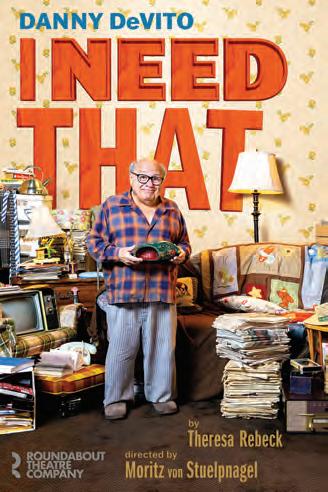
ExplorE 31
The 2023 Broadway show “I Need That,” shown here in rehearsals, offered a glimpse into the tensions hoarding can cause.



Roadmap to Florida’s Future
New initiative jump-starts projects that “will change lives for years to come”
How will the University of Florida shape the industries of the future? After UF received $130 million in new funding from the Florida Legislature this year, President Ben Sasse established that more than half of the funds would be directed to special strategic projects.
“We want to elevate UF’s reputation as a national research leader and innovator,” Sasse says. “We’ve been entrusted with resources from the state, and we’re putting those resources to work.”
The university community submitted more than 250 proposals, with 40 selected for funding.
“These exceptional initiatives will not only elevate UF’s standing as a national research leader but also transform lives here in Florida and around the world,” says Sasse. “We are facing and solving some of the biggest problems of our generation through the kind of interdisciplinary, collaborative work that will change lives for years to come.”
Here, we break down the projects and the impact they’ll have on the state, nation and world.
32 Spring 2024
AI and Technology

Industrialized Construction Engineering
Harnessing the power of digital design, AI, and robotic automation will enhance productivity, safety, and quality in residential and commercial construction. UF’s College of Design, Construction and Planning, and the Herbert Wertheim College of Engineering will seek to revolutionize how the world conceptualizes, designs, and builds affordable and resilient buildings and civil infrastructure.
“There will be huge societal benefits as we can tackle productivity, safety, quality, and resilience issues in the construction project delivery process,” says Dr. Chimay Anumba, dean of the College of Design, Construction and Planning.
UF’s Center for Advanced Construction Information Modeling and the Smart Industrialized Design and Construction Lab will expand their educational offerings and research on emerging technologies for civil infrastructure. The project will also create a first-of-its-kind undergraduate degree program in industrialized construction engineering, making UF a critical destination for researchers and students interested in the field. This tech-centered program will focus on environmental stewardship, as students research resilient construction practices and learn to use sustainable materials in their work.
“We are integrating AI, robotics, digital twins, and extended reality, which sets our program apart within the broader field of civil engineering,” says Dr. Eric Du, a civil engineering professor in the Engineering School of Sustainable Infrastructure & Environment. “By employing digital twin technology, we create dynamic digital representations of physical assets, enabling realtime monitoring and simulation of built environments.”
The program will focus on ways to expedite rebuilding efforts, ensuring faster recovery for disaster-stricken areas.
AI Passport for Health
A Virtual Experiential Learning Community will enable professionals in biomedical and healthcare sciences to acquire the skills needed to integrate artificial intelligence into their practices and research.
Research Software Engineers to Enhance and Scale Computer Research
A new team will use resources like the UF supercomputer HiPerGator to carry out technically advanced tasks for funded research projects, such as writing professional-quality scientific software, developing complex workflows involving data management and curation, and offering advice on research productivity and reproducibility.
“The creation of a new research software engineering team will further advance UF as a research powerhouse,” Sasse says. “It’s great for UF and great for Florida. Bolstering HiPerGator’s capabilities helps us attract the best researchers, graduate students, and entrepreneurial minds to the state.”
Having research software engineers across campus will enable a broader scale of computational research while enhancing UF’s profile and reputation, says UF Vice President and Chief Information Officer Elias Eldayrie.
“This investment from the university will reap benefits for many years. The kind of research software engineers we will hire is a recruiting edge to attract and support the best minds in the academy,” Eldayrie says. “This level of research support is cutting-edge now, but will become mandatory to attract and retain the best.”
Leveraging the Power of Large Language Models
A software tool will leverage the computing-intensive capabilities of HiPerGator, collecting beneficial data for instructors and administrators to offer interactive, personalized learning.
The team of researchers for the project is led by Dr. Laura Cruz Castro, an instructional assistant professor in UF’s Department of Engineering Education and the Department of Computer & Information Science & Engineering.
“Leveraging the power of large language models, we can better serve our students by giving them immediate, meaningful, and personalized feedback; these are critical components in keeping students engaged and learning actively,” Cruz Castro says.
The tool will be designed and piloted in the summer of 2024 for a large enrollment programming course that will impact nearly 2,500 students. Data will be collected to inform the researchers ahead of the program’s expansion to additional courses in the fall of 2024.

E xplorE 33
E xplorE 33

Health

Regional Center for Development of Advanced Therapeutics
A first-of-its-kind center in the Southeast will help bring to market treatments that expand on UF’s expertise in cell and gene therapy led by Dr. Barry Byrne, a professor and associate chair of research in the Department of Pediatrics and the director of the UF Powell Gene Therapy Center.
“The opportunity to develop transformative cell and gene therapy products for severe medical conditions will continue to position UF as an international leader in the new discipline of genetic medicine,” Byrne says.
Toward a Health Metaverse
As a responsive replica of UF Health operating and intensive care rooms, a new Intelligent Virtual Hospital will provide a unique learning environment for healthcare providers. The hospital will simulate scenarios to optimize real-world decision making and allow patients and providers to connect regardless of physical location, expanding possibilities for care delivery, training, and data management.
The project has the capability to improve healthcare processes in several ways, such as establishing a virtual command center; increasing educational opportunities, including virtual boot camps for health care professionals, industry experts, and AI developers; and expanding upon research endeavors for everything from new seed grants to clinical trials.
“This Intelligent Virtual Hospital will be unlike anything else in higher education, and it will bolster UF’s global and national reputation as a hub for AI in health,” says project leader Dr. Azra Bihorac, senior associate dean for research and the R. Glenn Davis professor of medicine, surgery, and anesthesiology in the College of Medicine. “By modeling and mirroring the physical hospital environment, there will be a host of exciting and innovative applications in education, scholarship, and health delivery.”
Expanding Access to Breast Cancer Screening in North Central Florida
A new mobile mammography unit will bring leading-edge technology directly to the rural 23-county area served by the UF Health Cancer Center, a region larger than Massachusetts, Rhode Island, and Connecticut combined. Rural communities have higher rates of advanced stages of breast cancer, higher mortality and high poverty rates, which often lead to significant barriers to preventive health care. Costeffective mobile units can help address these barriers and provide screening for other diseases. The unit is expected to begin operating this fall.
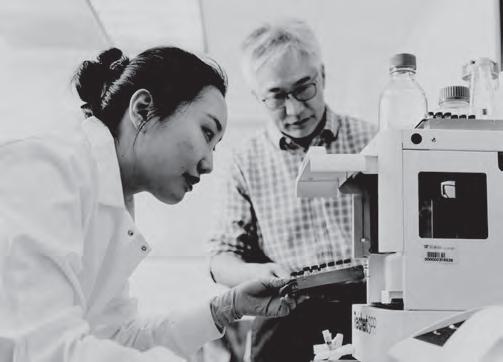
AI Applications to Pediatric Neuromedicine
Neuromuscular diseases currently affect more than 1 million children and their families in the United States. Combining a massive set of sophisticated muscle imaging data with UF’s powerful artificial intelligence computing can improve clinical trials for these diseases.
The project is led by Dr. Krista Vandenborne, a distinguished professor and chair of the Department of Physical Therapy in the College of Public Health and Health Professions. Vandenborne pioneered the use of MRI biomarkers to capture highly accurate and noninvasive measures of muscle changes in children with Duchenne muscular dystrophy.
These disorders can cause loss of reflexes, muscle weakness, and problems with balance and walking. In Duchenne muscular dystrophy, for example, muscles progressively weaken and lose the ability to regenerate after injury (so muscle tissue is eventually replaced with fat and collagen). Many children with Duchenne muscular dystrophy require a wheelchair by adolescence, and heart and respiratory systems are affected as the disease advances.
“In our decades of muscular dystrophy research, we have amassed a rich dataset of imaging and other biomarkers that represent millions of pieces of information characterizing the disease,” Vandenborne says. “Now, with the capabilities of AI, we can more quickly and accurately extract answers to treatment questions that will accelerate new therapies and bring us closer to a cure.”
Transforming Stroke Care
Stroke is the fifth leading cause of death and the No. 1 cause of disability in the United States, a growing challenge for Florida’s aging population. UF’s Evelyn F. and William L. McKnight Brain Institute is forming teams studying all aspects of stroke, from prevention and treatment to rehabilitation and imaging and pairing them with experts in artificial intelligence, machine learning, and data science. The project will provide a multidisciplinary learning experience, positioning UF as a leader in training the next generation of stroke researchers.
34 Spring 2024 34 Spring 2024

Precision Autism Center of Excellence
UF Health Jacksonville’s Precision Autism Center of Excellence will serve as a regional and national resource for individuals with autism and related neurodevelopmental disorders.
Dr. David Ledbetter, a medical geneticist in the Office of Research Affairs and the pediatrics and psychiatry departments at UF, envisions a center that will provide enhanced care for individuals with autism and related disorders, including intellectual disabilities, epilepsy, cerebral palsy, and congenital hydrocephalus. The initial focus will be on children, though adult care will also be included.
“Many of these children have underlying, rare genetic conditions that can now be readily identified by ‘reading’ their DNA sequence,” Ledbetter says. “Knowledge of each child’s specific genetic condition improves management and treatment, provides more accurate prognosis regarding future health problems, and informs reproductive planning for parents and relatives. In addition to improving care, the center will enhance training programs in neurodevelopmental pediatrics, medical genetics, and genetic counseling.”
The Precision Autism Center of Excellence is expected to expand the clinical capacity for diagnostic evaluation, management, and treatment, and significantly reduce the often-lengthy wait times at specialty clinics.
Center for Convening Transformative Care
A vision for enhanced patient care in Jacksonville will use data science statistics to establish population metrics, social factors of health, and community infrastructures for various health care strategies. UF’s College of Medicine, College of Nursing, and College of Pharmacy in Jacksonville oversee nearly 800,000 patient encounters annually across two hospital campuses and six emergency rooms. The colleges also oversee more than 60 UF primary and specialty care clinics, home visits, infusion services, and post-acute therapy services.
The center’s creation is expected to enhance care delivery, improve quality outcomes, and translate data-driven results to enhance personalized care for patients. It will also provide students and trainees with the tools and skills needed to increase patient safety, efficiency, and quality of care.
In-Space Biomanufacturing for Human Health Innovation Hub
Dr. Siobhan Malany and her College of Pharmacy team will conduct astrobiology experiments in space and on the ground to reveal the significant effects of low gravity on biological systems, expanding UF’s footprint in the rapidly growing in-space manufacturing sector.
MRI Vault
This project will design and build a vault to accommodate new MRI equipment acquired through a $3 million gift to the College of Veterinary Medicine from the Gauntt Foundation.
Creating an AI-Enabled Digital Imaging Platform for Veterinary Medicine and One
Health
Computerized records from animals treated at the University of Florida’s College of Veterinary Medicine could soon become a digital goldmine, embedding research into clinical operations to treat diseases like cancer.
A state-of-the-art, AI-enabled digital imaging platform will be developed to collect, collate, and analyze data across animal species. This first-of-its-kind veterinary learning health care system will create a path for the development of precision medicine customized to each patient with the aid of molecular and genomic data sets. It will also address bottlenecks in the pathway to implementing personalized cancer diagnoses and treatments.
“For researchers, this initiative will drive a continual cycle of discovery and clinical innovation,” says Dr. Janet Robishaw, the college’s associate dean for research and graduate studies.
In the first phase of the project, the college will focus on populating the data warehouse with digitized information amassed in diagnostic imaging, an area key to the veterinary oncology practice, as well as cell and tissue data that has been routinely collected from animal patients across UF’s various practice sites. With the second-highest small animal caseload among veterinary academic hospitals nationwide and more than 110,000 total cases, including large animals and field visits, the college offers a rich resource for data collection.
Subsequent phases of the project will deploy applications to resolve diagnostic and clinical problems and develop AI.


E xplorE 35 Health E xplorE 35

Agriculture and Environment

Modernizing IFAS Extension Through AI
A partnership between state, federal, and county governments to provide scientific knowledge and expertise to the public — is central to the mission of the University of Florida’s Institute of Food and Agricultural Sciences (UF/IFAS), encompassing thousands of Extension faculty members, scientists, educators, staff and volunteers. It’s about to get an upgrade spanning Extension offices on campus and in 67 counties by embedding state-of-the-art business intelligence software systems into the technology infrastructure. The technology will use AI to collect, store and analyze data produced by Extension agents and programs.
Dr. Andra Johnson, dean of the UF/IFAS Extension and the director of the Florida Cooperative Extension Service, says the improved technology will allow for better engagement across Extension.
“We are getting tailor-made solutions to complex problems into the hands of those who need it the most,” Johnson says.
The analytical tools will allow Extension professionals to make smarter and more proactive decisions, provide timely solutions, and measure program effectiveness. For example, better analysis of water resources and water usage could have an impact on water-saving techniques, leading to a significant number of gallons of water conserved via improved irrigation practices by agriculture and homeowners alike. Enhanced outreach programs with data-driven solutions could lead to optimized agricultural yields, better farming practices and increased economic returns for farmers and ranchers.
Innovation Hub for Urban Pest Management
UF’s Institute of Food and Agricultural Sciences (UF/IFAS) will create a new network focused on finding novel ways to manage bugs and pests in homes and businesses. The Innovation Hub for Urban Pest Management will have two objectives: to develop the workforce in the urban pest management industry and to provide new solutions to urgent pest and public health problems through research and new technology.
Recent industry studies on urban pest management have found that there is not enough skilled labor — from certificate-level technicians to future company executives — to meet the demand for pest management statewide. The initiative will support undergraduate and graduate students through internships and courses in a new online specialization, which will launch in the fall of 2024. The fully online urban pest management specialization will be offered within UF’s entomology major, preparing students for careers in the industry and providing a foundation in insect biology, applied entomology and business.
There is also a constant need for Florida’s pest management professionals to be equipped with the best tools to fight back against an ever-changing host of invasive species in Florida’s notoriously buggy urban environment. The prevalence of termites, tick-borne diseases and pathogens spread from flies, and pesticide resistance from species like German cockroaches are all concerns that will be researched at the Hub to develop more effective control strategies.

Agriculture and Landscape Worker Health and Safety
UF’s College of Public Health and Health Professions will create resources to prevent injuries associated with agricultural and landscape jobs across Florida.
The IFAS Plant Transformation Center
Citrus greening has caused a 70 percent to 80 percent reduction in production to Florida’s signature crop. A new center will help Florida farmers improve production of citrus and specialty crops, finding citrus varieties that can tolerate or resist citrus greening disease, also known as Huanlongbing.
Center objectives include:
• Developing rapid genome improvements for citrus.
• L everaging artificial intelligence to discover new gene functions to identify targets for genetic modification.
• Use clear communication and engagement with regulatory agencies to increase the transparency of the approval process.
• Infuse social science to ensure rapid adoption of new technologies among growers and the public.
• Effectively communicate to the public.
“We already have the nation’s leading university plant breeding program, and the center will turbocharge those efforts. We’ll start with citrus because that is a commodity in crisis,” says Dr. Scott Angle, UF’s provost and former senior vice president for agriculture and natural resources. “But I see the center’s portfolio rapidly expanding to include other crops.”
36 Spring 2024
36 Spring 2024
Humanities and the Arts
Arts Impact Engine

A research team will help faculty and students write competitive proposals for external funding opportunities, advancing UF’s fast-growing and highly grant-funded arts program.
“The College of the Arts is expanding tremendously, and the Arts Impact Engine will only fuel that growth,” Sasse says. “This initiative will undoubtedly lead to more opportunities to fund and showcase our amazing arts program.”
Digital Humanities Lab
This lab will offer coursework, experiential learning, and professional development opportunities to students and faculty, as well as invite a cross-section of Floridians to engage with UF’s research through public-facing content developed across a range of new media.
A physical and virtual hub for UF’s humanities researchers who work with big data, augmented reality, and digital storytelling tools, the Digital Humanities Lab will also help humanities students gain skills necessary for the modern workforce.
The lab will break down silos between academic disciplines, showcase research, and build stronger collaborations with private industry and cultural organizations across the state.
The result is a win-win for UF and the state of Florida, according to Dr. Trysh Travis, associate dean of the College of Liberal Arts and Sciences.
“After centuries of communicating on paper, digital humanities scholars have developed new ways to generate and share information. Fluency in data analytics, with visual and interactive media, will improve the quality of our humanities research,” Travis says. “Equally, if not more important, it will allow our researchers to build stronger collaborations with private industry and cultural organizations across the state.”
Journal of Arts in Health
As the Center for Arts in Medicine creates the global field of Arts in Public Health, this initiative will launch a new open-access journal for the industry that will cement UF’s place as a leader in integrating arts and public health.
K-12 Education

UF Stars: Illuminating Pathways for Undergraduate Research and Innovation
UF Students as Research Scholars (STARS): Illuminating Pathways for Undergraduate Research pairs undergraduates with faculty for research opportunities, increasing University Scholars Program applicants, growing participation in the College of Education Research Symposium, supporting graduate assistantships and rewarding excellence in faculty mentorship.
Project ECHO — Revolutionizing Teacher Preparation with Augmented Reality
The initiative will incorporate augmented reality technologies into an online early childhood education teacher certification program.

SALT-Math: Scalable AI-Augmented Learning by Teaching for Math Education
Could turning students into teachers revolutionize K-12 mathematics learning?
The SALT-Math: Scalable AI-Augmented Learning by Teaching for Math Education will implement a learningby-teaching framework that uses a large language model to flip students’ roles as teachers to AI agents, resulting in enhanced student outcomes. SALT-Math will be created and distributed in the Lastinger Center for Learning’s Math Nation platform, which was adopted as the core K-12 math curriculum in Florida and engages more than 1 million K-12 students across the United States each year.

E xplorE 37
E xplorE 37

Cross-campus Collaboration

While all of the strategic initiatives emphasize collaboration, these 10 projects are especially interdisciplinary, tapping into UF’s breadth and depth to shape Florida’s future.
UF Space Mission Institute
Researchers with a wide range of space expertise will come together to answer the most demanding questions related to space exploration, development, and commercialization in a new space mission institute. Managed by UF Research, the institute will be a hub where scientists and scholars from across UF — including those from the Institute of Food and Agricultural Sciences (IFAS), the Herbert Wertheim College of Engineering, the College of Pharmacy, and the College of Liberal Arts and Sciences — can collaborate, conduct research, and innovate.
UF has nationally recognized faculty leaders in all the major National Aeronautics and Space Administration fields, as well as more than 100 faculty members conducting space research.
“UF has a long and distinguished history of research in space — from low-Earth orbit to the moon and Mars and beyond, but this new institute will provide a vehicle for a diverse group of researchers to collaborate in new and exciting ways,” says Dr. Rob Ferl, assistant vice president for research and a distinguished professor in IFAS, who will direct the institute. “This will position UF to play a more prominent role in space exploration research in the state, the nation, and the world.”
Institute members will work to enhance existing relationships with Space Florida and the Space Life Sciences Laboratory at the Kennedy Space Center, and seek new partnerships with the International Space Station National Laboratory. The institute will also work to leverage UF’s proximity to the growing commercial space ecosystem in Florida. In addition to working with the aerospace industry, the institute will seek closer ties with the United States Space Force to join space science with defense goals, and provide new opportunities for students in the Reserve Officer Training Corps program.
UF and the Gulf
A new Gulf Scholars program will promote interdisciplinary research and experiential learning focused on the challenges facing communities along the Gulf of Mexico. Based in the Bob Graham Center for Public Service, the program will partner with the College of the Arts; Design, Construction and Planning; the Agricultural and Life Sciences; Engineering; and Journalism and Communications.
UF & Sport Collaborative
With seed funding for a variety of sports-related proposals, this multi-college initiative will propel UF to the global stage in sports performance and healthcare while illuminating its world-class sports facilities and partnerships.
In partnership with the University Athletic Association, the College of Health and Human Performance, the Warrington College of Business, the College of Journalism and Communications, the College of Medicine, and the Herbert Wertheim College of Engineering are collaborating to launch the following projects:
• Sport and Health Leaders: A certificate program will increase students’ understanding of athletes and the factors that influence their wellbeing. “Our experts will address topics ranging from athlete development to sport analytics, from video journalism to wearable sensor technology,” says Dr. Michael Reid, dean of the College of Health and Human Performance. “The results are sure to innovate sports, strengthen related industries, and help drive the Florida economy.”
• Gator AccelerAItor for Sport Analytics: The College of Health and Human Performance and the Warrington College of Business will partner with the UF’s men’s basketball team to improve recruitment, player evaluation, scouting, and game strategy through AI tools. The project will also develop a master’s degree program in AI and Sports Analytics, and provide students with a real-world laboratory for working with teams and athletes.
• A I-Powered Athletics: The Herbert Wertheim College of Engineering and the UAA will build an infrastructure to enable AI-powered athletics based on the wearable sensor and health data of student athletes. Funded projects may generate pilot data and initial publications that lead to large-scale research proposals for federal agencies.
• Transforming Sport Science Research for Every Body: The College of Medicine will help advance the analytic capacity of the UF Health Sports Performance Center, making it a centerpiece of research and testing for ablebodied and para-athletes of all ages and fitness levels. The Center will advance precision treatment, performance training, and research inclusivity for athletes. “The team aims to better predict specific sport-related injuries and to predict responsiveness to medical treatment after injury, while developing new training programs for students in sports medicine research,” says Dr. Jennifer Hunt, interim dean of the College of Medicine.
• Gator Nation Gameday Live: The College of Journalism and Communications will offer students an opportunity to produce a live, one-hour sports preview show, modeled after ESPN’s “College GameDay” program.
38 Spring 2024
38 Spring 2024
Research & Technology Innovation Incubator
A hub for interdisciplinary research will establish the Norman Fixel Institute for Neurological Diseases at UF Health as an international destination for leading-edge science and collaboration.
“We must rise to meet the growing challenges of neurodegenerative diseases, such as Parkinson’s, ALS, Alzheimer’s, dystonia, CTE, and many others,” says Dr. Michael S. Okun, director of the Fixel Institute. “The Fixel Institute is the ideal place to do this and do it now.”
The facility will house researchers from several UF colleges, including the Herbert Wertheim College of Engineering, the College of Medicine, the College of Nursing, the College of Health and Human Performance, the College of Public Health & Health Professions, and the College of the Arts and support new artificial intelligence and imaging hires.
UF Promoting Interdisciplinary Use of Neurotechnologies to Enhance Education, Research, and Service (PIONEERS)
Partnering with UF’s Herbert Wertheim College of Engineering and UF Design, Construction and Planning, the College of Education aims to purchase and deploy a neurotechnology lab that transforms educational research and practice.
Florida’s Digital Twin
The design and construction of a statewide digital twin technology program will reduce barriers to cross-campus collaboration and engagement between UF faculty and researchers and public- and private-sector stakeholders.
“Digital-twin technology has become an increasingly critical tool across industries and higher education,” UF Vice President for Research David Norton says. “AI has the potential to enhance its capabilities even further, and UF is equipped to move us in the right direction.”
FinTech Research Center
Software and technologies that power financial industries — along with everyday transactions like mobile payments — are the center of Warrington College of Business’ new FinTech Research Center. Projects will arise from faculty-industry collaborations with partners in Jacksonville, Tampa, and South Florida, serving Florida’s rapidly growing fintech sector.
Charting the Course to Preeminence in National Security Leadership
Partnering with the Office of Government and Community Relations and the Hamilton Center, the Herbert Wertheim College of Engineering aims to accelerate the long-term positioning of UF as a trusted partner for research, policymaking and workforce development with federal agencies responsible for national security and defense.
News/Immersion Expansion
Expands student journalism coverage of the environment and small business and natural disasters and emergencies.
Law Degree Revamp and Expansion
Revamps and expands program to award a Master of Law in U.S. Law, develop master’s programs in Legal Studies.
Connect Students with Cultivated and Natural Spaces to Promote Wellness
Builds on the success of horticultural therapy programs to decrease stress and mental fatigue and improve the selfesteem of UF students.
Experiential Learning Platform
Differentiation of Warrington College of Business undergraduate, MBA and MS programs through experiential and practicum programs where students work on projects with partner companies and non-profit organizations.
Comprehensive Student Housing Market Study
Supports UF’s prioritization of on-campus student housing by conducting a market study of UF’s on- and offcampus housing inventory.
Outdoor Wireless Expansion
Improves student wireless connectivity throughout campus.
Virtual Patient Simulation and AI-Enabled Learning to Support Interprofessional Collaboration
Teaches students and residents from multiple health colleges how to address healthcare needs, pharmacology, cultural sensitivity and empathy with a virtual patient simulation using AI and Chat GPT, underscoring the necessity of communicating with all healthcare providers during treatment.
For more information about the projects and their progress, visit news.ufl.edu.

E xplorE 39
xplorE 39 Other Initiatives

Musical Marvel
Hollywood has taken notice of this engineer-turned-composer’s AI-infused art
by Alisson Clark
40 Spring 2024
How do you capture the sound of the stars?
That was the challenge placed before composer
Tina Tallon for the score of a Marvel movie, no less.
Tallon, an AI and the Arts professor at the University of Florida, had a solution at the ready: a computer model she coded that turns spectral data from stars into sound.
“When you burn different elements, they give off certain colors of light or different types of electromagnetic radiation. That’s one of the parameters astronomers use to determine different properties of stars,” she explains. “I had already started playing with those absorption and emission wavelengths and turning them into sound in graduate school.”
Her turn as a Hollywood composer is just the latest in a series of creative reinventions for Tallon, who studied biomedical engineering as an undergrad at the Massachusetts Institute of Technology before realizing, in her senior year, that she wanted to make music.
“My parents were obviously intensely concerned about my ability to pay my rent and put food on the table,” she recalls.
But Tallon faced a more immediate challenge.
“I had taken a musical analysis class at MIT and I was just really, really intrigued by it. I remember coming into my professor’s office, and saying, ‘I think I might want to go to music school. He said, ‘if you’re going to apply to composition programs, you have to have actually composed things.’ I had to write a ton of music and get it performed and recorded in a month and a half.”
She pulled it off, but after graduate school, found that teaching at conservatories left her engineering expertise on the shelf. That changed when she came to UF in 2021.
“I do a lot of collaborations with people in medicine and engineering,” she says. “At a conservatory, they’re not interested in that. You teach the students how to write a string quartet, and that’s it. It’s really wonderful that I’ve found a position that allows me to bring all of myself and all of the things I do to the table.”
Her contributions to the score for “The Marvels” are a prime example. Using the sonification model she created, Tallon turned spectral data she pulled from astronomy research into low-frequency warbles and otherworldly glissandos that underpin composer Laura Karpman’s compositions. Central to her approach is ensuring her sonifications are more than just pretty sounds.
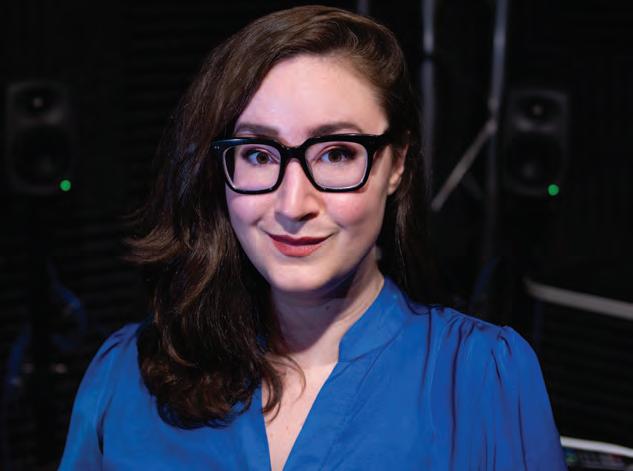
“I want to make sure that I’m actually communicating something immutable about the data set,” she says. “You could just take an image, translate it into a spectrum and map it to different parameters, but if you turn that same picture 90 degrees, you’re going to get completely different sounds. What is it actually telling you about the data?”
In a forthcoming study, Tallon and an undergraduate student proposed the sonification model as a way to make star data more accessible to blind and low-vision astronomers.
“This isn’t just a way to make cool sounds, it’s something that could be really helpful,” she said.
Throughout her work, Tallon wants to show that AI can empower artists and fuel their creativity, not just mine their creations to build its models.
“There are a lot of fantastic things that we can use AI for, particularly building these collaborations between artists and scientists or people across all different disciplines,” she says.
“That isn’t about extraction or exploitation, it’s about how we can work together to be more inclusive and facilitate more open dialogue more nuanced, sophisticated conversations about what it is to be human.”
Tina Tallon, PhD Assistant Professor of AI and the Arts, Music Composition, College of the Arts tallonc@ufl.edu
ExplorE 41
Tina Tallon’s engineering background informs her approach to AI in the arts. “I’m really grateful to have found a way to bring it all full circle.”
ExplorE 41

As “Jaws” turns 50, a scientist shares its impact — and current shark-attack trends
When Peter Benchley published his bestseller “Jaws” in 1974, the novel and subsequent blockbuster movie fanned our fear of sharks into a wildfire, says Dr. Gavin Naylor, director of The Florida Program for Shark Research. Naylor reflected on the enduring impact of “Jaws” for the news site “The Conversation,” excerpted here.
“Virtually all audiences embraced the idea, depicted vividly in the movie and its sequels, that sharks were malevolent, vindictive creatures that prowled coastal waters seeking to feed on unsuspecting bathers. But “Jaws” also spawned widespread interest in better understanding sharks.
Previously, shark research had largely been the esoteric domain of a handful of academic specialists. Thanks to interest sparked by “Jaws,” we now know that there are many more kinds of sharks than scientists were aware of in 1974, and that sharks do more interesting things than researchers ever anticipated. Benchley himself became an avid spokesman for shark protection and marine conservation.
In my own 30-year career studying sharks and their close relatives, skates and rays, I’ve seen attitudes evolve and interest in understanding sharks expand enormously … After “Jaws,” shark research quickly went mainstream. Graduate students lined up to study shark behavior, and the number of published shark studies sharply increased.
Field research on sharks expanded in parallel with growing interest in extreme outdoor sports like surfing, parasailing and scuba diving. Electronic tags enabled researchers to monitor sharks’ movements in real time. DNA sequencing technologies provided cost-effective ways to determine how different species were related to one another, what they were eating and how populations were structured … We now know that juvenile white sharks feed almost exclusively on fishes

and stingrays, and don’t start incorporating seals and other marine mammals into their diets until they have grown to about 12 feet long. Most confirmed white shark bites on humans seem to be by animals that are between 12 and 15 feet long. This supports the theory that almost all bites by white sharks on humans are cases of mistaken identity, where humans resemble the seals that sharks prey on.
Although “Jaws” had a widespread cultural impact, it didn’t keep surfers and bathers from enjoying the ocean. Data from the International Shark Attack File on confirmed unprovoked bites by white sharks from the 1960s to the present day shows a continuous increase, although the number of incidents yearly is quite low. This pattern is consistent with growing numbers of people pursuing recreational activities at the coasts.
Around the world, there have been 363 confirmed, unprovoked bites by white sharks since 1960. Of these, 73 were fatal. The World Health Organization estimates that there are 236,000 deaths yearly due to drowning, which translates to around 15 million drowning deaths over the same time period. In other words, people are roughly 200,000 times more likely to drown than to die from a white shark bite. Indeed, surfers are more likely to die in a car crash on the way to the beach than they are to be bitten by a shark.”
42 Spring 2024
Gavin Naylor
The 2023 report from the University of Florida’s International Shark Attack File, released in February, reflects these trends, with 69 confirmed unprovoked bites. Although this is higher than the previous five-year average of 63 attacks, the data remain consistent with long-term trends.
Ten of the past year’s unprovoked attacks were fatal, up from five the year before. Australia accounted for 22% of all attacks, but made up 40% of fatalities. There were also two confirmed deaths in the U.S., and one each in the Bahamas, Egypt, Mexico and New Caledonia. Other confirmed, non-fatal bites occurred in Costa Rica, Colombia, Brazil, New Zealand, Seychelles, Turks and Caicos, Ecuador (in The Galápagos Islands) and South Africa.
“This is within the range of the normal number of bites, though the fatalities are a bit unnerving this year,” Naylor said.
The United States had 36 unprovoked attacks, accounting for 52% of incidents worldwide. Of these, two one in California and another in Hawaii were fatal. As in previous years, Florida had more shark bites than any other state, with 16 attacks.
ISAF’s records include an additional 22 attacks last year that were intentionally or unintentionally provoked. The most common victim activity at the time of provoked attacks was spearfishing.
Despite the increase, the number of bites and fatalities that occurred in 2023 are within the average for the last decade. While the odds of being bitten by a shark are incredibly low, ISAF provides recommendations for further precautions people can take. These include staying close to shore, not swimming at dawn or dusk, and avoiding excessive splashing.
Scan the QR code to read the full Conversation article.
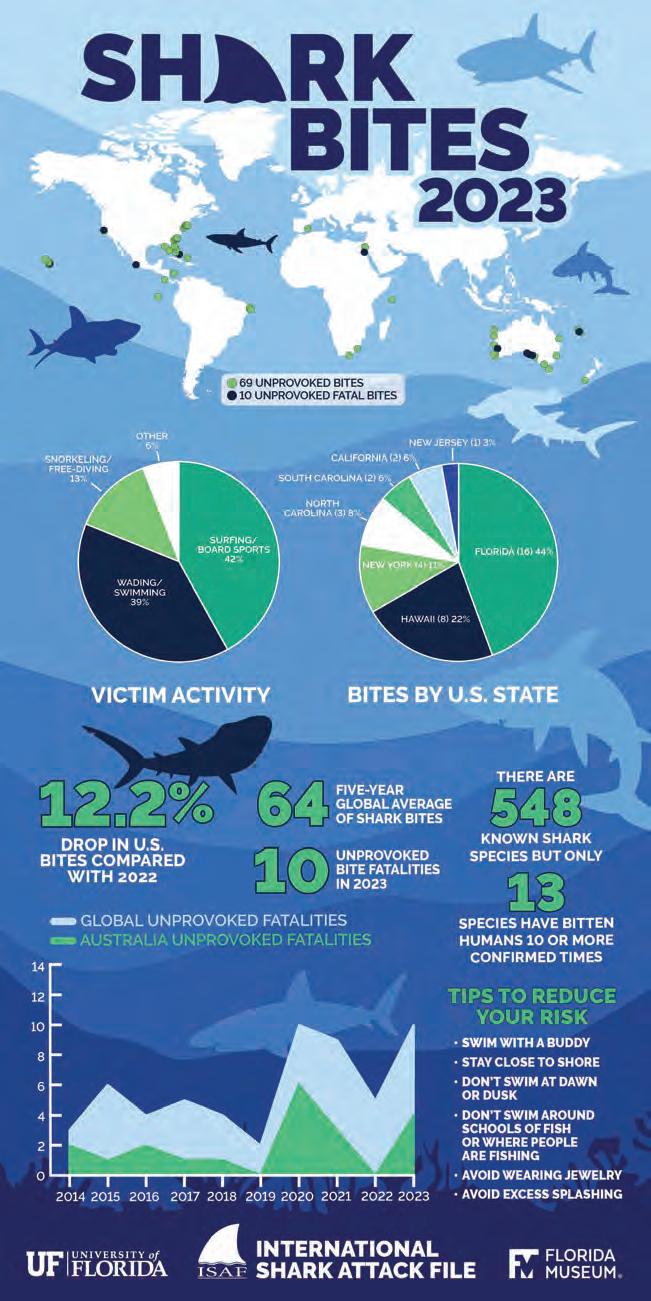
ExplorE 43

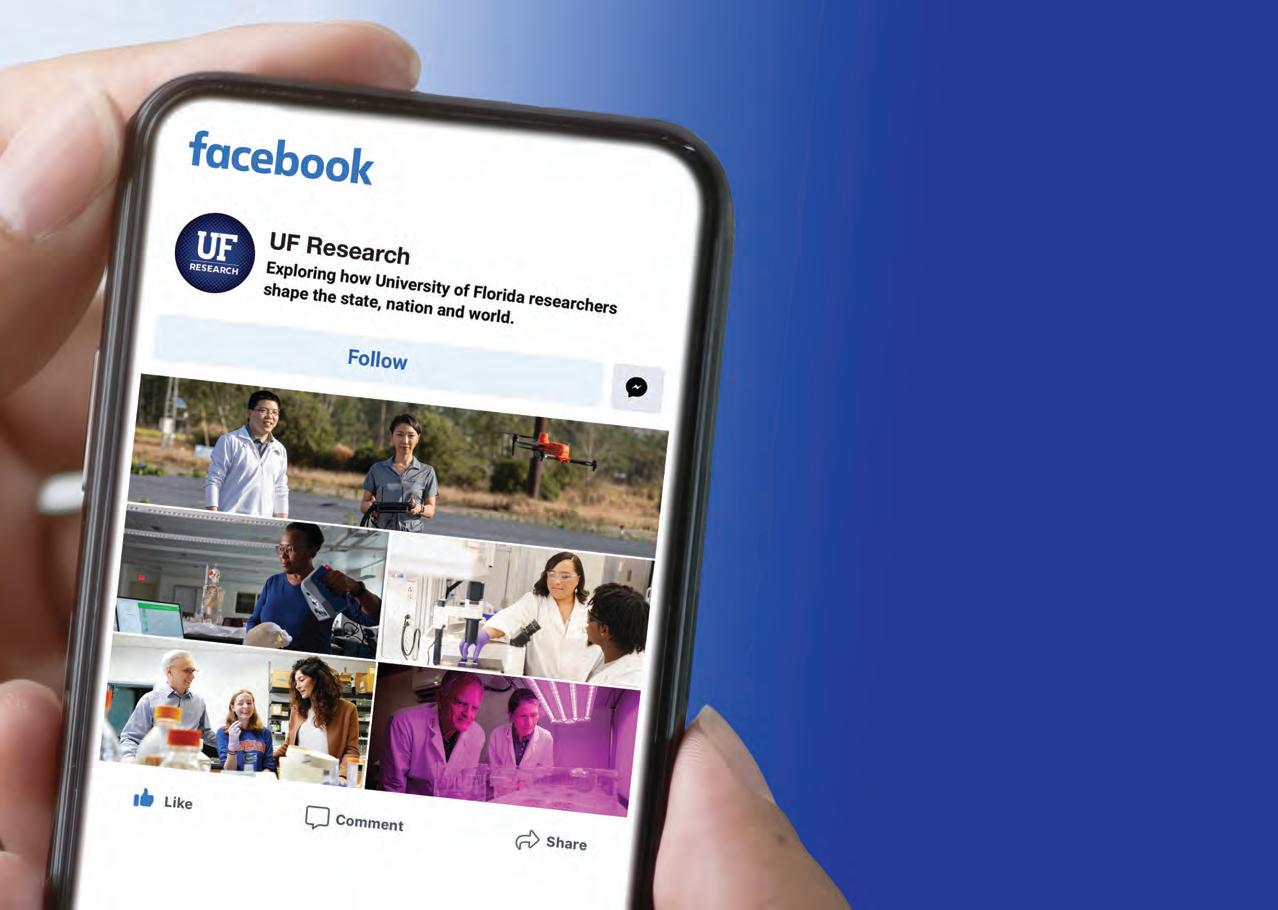




Explore Magazine Box 115500
Non-Profit Organization U.S. Postage PAID Gainesville, FL Permit No. 94 Scan this code to join our mailing list or update your mailing address. Visit us online: explore.research.ufl.edu uf.research University of Florida Research UF Research UFresearch For the latest on UF research, follow us on social media. UFexplore
Gainesville, FL 32611-5500

 About the cover: Chemist Matthew Disney in his lab at the Herbert Wertheim UF Scripps Institute for Biomedical Innovation & Technology in Jupiter, Florida.
About the cover: Chemist Matthew Disney in his lab at the Herbert Wertheim UF Scripps Institute for Biomedical Innovation & Technology in Jupiter, Florida.







 David P. Norton Vice President for Research
David P. Norton Vice President for Research








 Win Phillips
Win Phillips


 Chemist Matthew Disney is leading a
Chemist Matthew Disney is leading a




































































